|
|
 |
|
T h e R e t i n a G u i d e
|
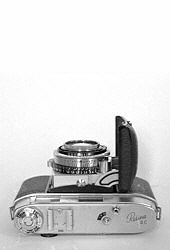 These web-pages have been scanned and converted from a photocopy of the "Focal Press" publication "Retina Guide", 1965 edition. Consequently they do not cover the later model S1 and S2 Retinas. There may be reference to "current" and "discontinued" models. Obviously all Retina cameras are now long discontinued, but For ease of editing if nothing else, all the original text has been retained.
These web-pages have been scanned and converted from a photocopy of the "Focal Press" publication "Retina Guide", 1965 edition. Consequently they do not cover the later model S1 and S2 Retinas. There may be reference to "current" and "discontinued" models. Obviously all Retina cameras are now long discontinued, but For ease of editing if nothing else, all the original text has been retained.
The original book was divided into two sections, effectively an overview and a "green pages" section covering specific models in more detail. I've not bothered with a green background to these pages, but hopefully I will have included links where appropriate to the relevant text.
|
Table of Contents
- The Retina System
- Retina Evolution
- Handling the Retina
- Loading and Unloading
- Films and Filters
- Exposure
- Flash with the Retina
- Camera Care in Tropical Climates
- Using Alternative Lenses
- The Retina IBS, IF and IIF
- The Retina IIS and IIIS
- The Retina Automatic I, II and III
- The Retina Ib, IB, IIc, IIC, IIIc and IIIC
- The Retina I, Ia, II and IIa
- The Retina S Lens System
- The Retina C Lens System
- Retina Accessories
- Facts and Figures
|
The Retina System
The Retina is fundamentally a simple 35 mm. camera. A range of different models in this series provides a choice of a camera with or without built-in rangefinder and/or photo-electric exposure meter, the latter uncoupled or coupled to the exposure setting, with or without interchangeable or convertible lenses.
All use the same rigid body casting with specially machined film track. The film transport lever is mounted underneath the baseplate. One full swing of the lever winds the film, advances the film counter and re-tensions the shutter. Double exposures are possible by a deliberate procedure of disengaging the transport sprocket by means of the reversing button. The film transport lock can also be released (for advancing the film without exposing it; e.g., when reloading partly exposed film) by means of a special film release button.
The back of the Retina is hinged on. A tripod bush is fitted into the baseplate and an accessory shoe in the top; film type and depth of field indicators are provided. The body is leather covered with satin chrome trim. An automatic exposure counter shows the number of exposures still available.
The camera takes standard 35 mm. cassettes.
The viewfinder is an optical direct-vision finder which shows the field of view outlined by a brilliant frame apparently suspended in space. It is possible to follow moving subjects even before they enter the actual picture area. Small marks on the frame indicate the reduced field for near subjects, acting as parallax correction marks. Alternatively, the frame may be coupled to the focusing mechanism for automatic parallax correction.
The shutter of the Retina models without built-in exposure meter or, with the meter not coupled to the shutter setting, is calibrated in exposure values in addition to the usual shutter speeds. The aperture and shutter speed controls are cross-coupled. At any given exposure value setting, choosing a faster speed automatically opens up the lens aperture and vice versa to keep the exposure constant. If desired aperture and shutter speed can be set independently.
Retina Evolution
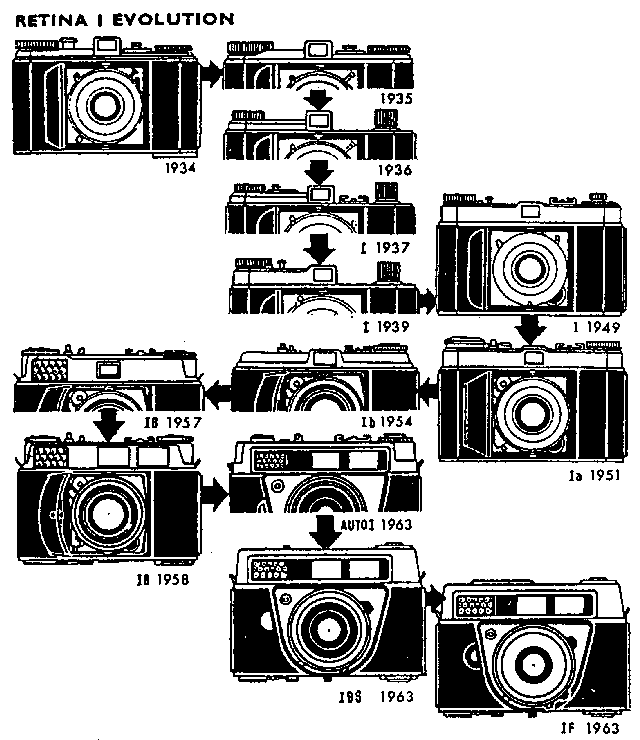
The first Retina model appeared in 1934 and underwent various changes in appearance and layout until 1949. Models from 1937 onwards were named Retina I to distinguish them from the Retina II appearing that year. The Retina Ia of 1951 had a rapid winding lever on the top of the body. The model Ib of 1954 featured a completely redesigned body. The Auto and IBS of 1963, abandoned the folding principle. They are completely rigid cameras, as is the IF of 1963, which features built-in flashgun and exposure meter.
* The first Retina II with coupled rangefinder appeared in 1937 and like succeeding models, followed the general specifications of the then current Retina I. This first model already had a body release and double exposure lock, the film lock being coupled with the shutter release button. The viewfinder and rangefinder were separate and the camera was available with a choice of lenses from f3.5 to f2.
* The 1939 model had a had a modified rangefinder, combined in one eyepiece with the viewfinder. The rangefinder was further improved in design in 1946. The 1949 model included a film indicator and a depth of field scale directly opposite the distance scale (on earlier models the depth of field calculator was a separate fitting on the camera base).
* The Retina IIa of 1952 provided the same improvements as the model Ia with a rapid winding lever and redesigned film track for maximum accuracy and flatness of the film.
* The Retina IIc with its modern rounded body shape appeared in 1954 and also featured the convertible lens system of later models. The IIIc with built-in exposure meter was added to the range at the same time.
Minor modifications took place between 1954 and 1957 (rearrangement of the position of the aperture scale, etc.), and in the latter year the original two-range exposure meter of the IIIc was replaced by a single-range instrument.
* The latest models IIC and IIIC of 1958 differ from their immediate predecessors in the new large-size finder with multiple reflected-image frames (making accessory finders for alternative focal lengths unnecessary) and a slight change in outward appearance (deeper top housing, larger finder windows).
* The Retina IIIS model of 1958 again takes a different direction : apart from having a coupled exposure meter and fully interchangeable lenses, it also has a rigid body. The Retina IIS model introduced in 1959 is similar to the IIIS but without interchangeable lenses.
* The Retina Automatic I of 1960 is similar in appearance to the Retina IIS, having a rigid body, but no rangefinder. The shutter has no speed or aperture scale; taking a meter reading selects a suitable aperture-speed combination.
* The Retina Automatic II of 1962 is as Automatic I, but with shutter speed scale (1/30 to 1/500 sec.) permitting preselection of shutter speeds. The lens is the four-element Xenar f2.8.
* The Retina Automatic III of 1962 is as Automatic II, but has a built-in coupled rangefinder.
* The Retina IBS of 1962 has a rigid body with built-in photo-electric meter coupled to the shutter speed and aperture.
The Retina IF of 1963 is similar to the Retina IBS, but has flash built into the camera top plate.
The Retina IIF of 1963 is as model IF, but with built-in range-finder coupled to the lens.
Full details of the handling of the various models are found in the green pages of this guide.
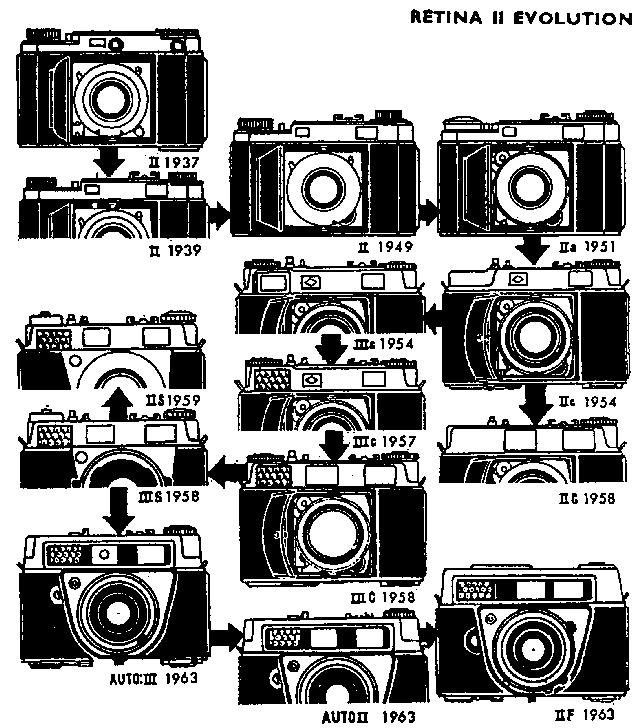
The Retina II with coupled rangefinder made its first appearance in 1937. On later models the rangefinder and viewfinder were combined in one eyepiece, leading up to the IIa of 1951 with rapid winding lever. The models IIc and IIIc of 1954 featured a new body construction. All IIIc and IIIC models have a built-in exposure meter. The Retina IIS and IIIS (the latter with interchangeable lenses) as well as the Auto models and the IIF abandon the folding principle and are completely rigid cameras with coupled exposure meter. The IIF is the same as the IF but has a coupled rangefinder.
THE RETINETTE AND RETINA REFLEX. During the growth of the Retina series two off-shoots appeared which established themselves as successful camera types of their own. Although made by the same manufacturer and bearing a certain family resemblance to the Retina, they are essentially different camera types. They are, therefore, not included in this book, but dealt with in separate Camera Guides of their own: the Retinette Guide and the Retina Reflex Guide.
* Discontinued models.
|
Handling the Retina
In order to simplify the description and handling of the Retina camera without being confused by different features of individual models, this guide has been divided into a general section which applies to all Retina models, while the requirements and consequently different handling of each model are found on the green pages.
For convenience, a symbolic reference system is also used in the general section. Wherever the sign ‡ appears, further details will be found in the camera pages of the green section for each camera type. The sign • similarly refers to lens details in the green section and the sign •• to accessories. The appropriate pages are marked accordingly in the bottom left- or right-hand corner.
Holding
It is obvious that the camera should be held as steady as possible, as the slightest shake, even if not seen in the negative, will become visible in the enlargement. Always stand with your legs apart.
FOR HORIZONTAL PHOTOGRAPHS hold the camera horizontally against your nose while looking through the finder with one eye. Keep both elbows close to the body. Press the right thumb against the back of the camera, let the right index finger rest on the release, while the right middle finger, bent downwards, presses against the camera front. The left hand grips the camera body on its left side, with the index finger -on cameras with rangefinder- on the focusing lever.
FOR VERTICAL PHOTOGRAPHS rest the camera upright against forehead and nose, gripping the camera top with the left hand, left thumb against the camera back and -on models with rangefinder- the left middle finger on the focusing lever The right hand holds the Retina from below, right thumb on the release, the camera resting in the palm of the right hand.
To release the shutter, press the release with the ball of the finger (or thumb). Use finger pressure only and keep the hand and its grip on the camera steady. The actual pressing down must be done slowly and smoothly. The slower the exposure time, the smoother must be the release.
For slow exposures in the hand it is advisable to rest the elbows or at least to lean the body against some support in order to avoid shake. In this way 1/15, 1/8 and even 1/4 sec. can be risked without camera shake. Such a support is also desirable for faster exposures. A slightly unsteady hold may easily lead to blurred pictures.
The use of a tripod is necessary when taking time exposures and it is also recommended for speeds from 1/15 to 1 sec. For upright photographs from the tripod, use a ball-and-socket head to allow changing from horizontal to vertical position.
|
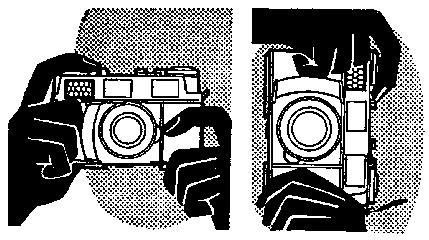 Left: Holding current Retina folding models. The left index finger operates the focusing knob; the right index finger presses the release button. Keep all fingers clear of the rangefinder windows. With the rigid Retina models the hold is substantially the same.
Left: Holding current Retina folding models. The left index finger operates the focusing knob; the right index finger presses the release button. Keep all fingers clear of the rangefinder windows. With the rigid Retina models the hold is substantially the same.
|
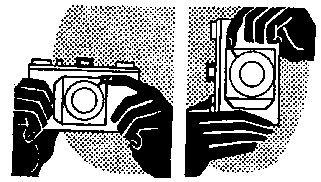 Right: Holding old Retina models without body release. The left index finger presses the release plunger on the front of the shutter.
Right: Holding old Retina models without body release. The left index finger presses the release plunger on the front of the shutter.
Below: The rapid winding lever of current models is in the camera base and operated by the right thumb (left). On models Ia and IIa (right) the rapid winding lever is on the top of the body.
|
 Below: To keep the camera steady during the exposure, support your body wherever possible against something solid (e.g., a tree) or prop up your elbows against your knees or other support. Use a cable release for time exposures from a tripod.
Below: To keep the camera steady during the exposure, support your body wherever possible against something solid (e.g., a tree) or prop up your elbows against your knees or other support. Use a cable release for time exposures from a tripod.
|

Carrying
To be ready for quick action it is best to carry the camera on a short strap around the neck so that it lies on your chest. Lifting it up to the eye then is a matter of a split second.
For convenience and protection, the Retina should always be carried in its ever-ready case. The case is designed to hold the camera ready for use. A retaining screw holds the camera securely in the case, even when open.
Viewing and Focusing
The viewfinder of the Retina shows the subject in almost natural size. Looking through the finder, you can clearly see the brilliant reflected frame which outlines the exact field of view of the lens.
However, the area just outside this field of view is also visible. You can thus watch the immediate surroundings of the subject to be taken. You can also leave the other eye open (this may require a few minutes of practice) and observe the wider surroundings of the subject as well. This is an asset when taking candid shots.
Note that with near subjects at 2½ to 6½ ft. the camera field of view as indicated by the finder is displaced downwards if the camera is held horizontally and sideways if held vertically. This displacement (technically called finder parallax) is indicated by two short lines in the brilliant frame.
When taking subjects at such close range, the actual field covered is that indicated at the top by these short lines, but the corresponding area is added to the opposite side (below the base of the reflected frame when the camera is held horizontally). The exception is the Retina IIIS, which has automatic parallax compensation with the brilliant frame coupled to the distance setting.
The current Retina models with convertible and inter-changeable lenses show also the field of view of the wide-angle and telephoto lenses by means of additional reflected-image frames within the subject field.
The viewfinder of Retina models prior to 1954 is of the direct vision type and should be held close to the eye. Do not attempt to turn the camera to the right or left, away from the eye; nor must the eye be moved from the centre of the eyepiece to, find the limitation of the field of view. This "spying round the corner" is deceptive, as the negative includes only what you see in the finder when holding the eye close to, and in the centre of, the eyepiece while looking straight ahead. The field of view is exact for photographs taken at 9 to 12 ft. distance. At infinity a trifle more appears on the negative than seen through the finder, and at 3½ to 6 ft. a shade less.
To obtain a sharp negative, set the distance from camera to the subject as accurately as possible. On Retina models without built-in rangefinder, estimate or measure it with a separate rangefinder or other aid. On these models, the distance is set by turning the focusing scale until the required distance figure is opposite the distance index mark.
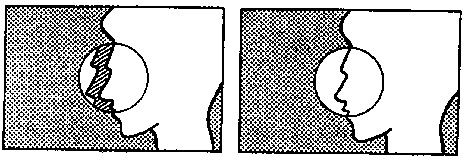
The coupled rangefinder of most Retina models has a central area (circular on current models, diamond shaped on some earlier ones) in which the subject appears with double outlines. To focus, simply turn the lens mount until the two images in the rangefinder field fuse into one. This automatically sets the lens at the correct distance.
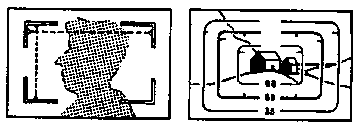
Right: On later Retina models a white frame visible in the finder outlines the subject area. The marks near the corners indicate the parallax correction at close range (dotted lines).
Above right: On current folding Retina models with interchangeable lenses the finder incorporates a series of frame lines to cover the fields of view for the different focal lengths. Each frame line still carries parallax correction marks.

Above: The Retina IIIS has several frames in the viewfinder to indicate fields of view with different lenses. These frames are changed automatically on inserting the appropriate lens. With the standard lens the outer frame (for the wide-angle lens) and the inner frame (left) is visible. With the wide-angle lens only the outer frame remains (centre), while the long-focus lenses make smaller inner frames visible (right). All frames are coupled with the focusing movement for automatic parallax correction.
On the Retina models with coupled rangefinder the latter measures the distance and at the same time brings the camera lens automatically into correct focus. To use the rangefinder, look through the combined viewfinder/rangefinder eyepiece. You will see a bright circular field (on earlier models diamond-shaped or rectangular in the centre), and in this field the image of the subject appears double. On slowly turning the lens focusing mount, the two images will fuse into one. Stop when the two images are superimposed. The lens is then focused accurately on the subject.
The orthodox way of rangefinder focusing just described is suitable for stationary or very slow-moving subjects. For action subjects a different method of focusing is suggested. There you set the camera and the rangefinder to a distance at which the subject will be at a given moment, or focus on a spot which the subject has to pass. Watch the scene in the rangefinder, and press the release button when the two rangefinder images coincide, indicating that the subject has reached the pre-focused point.
With subjects liable to react self-consciously (e.g. children), set the lens to a suitable distance and then approach your subject quickly, exposing as soon as the two images coincide in the rangefinder.
Alternatively, focus on some object which is the same distance from the camera as your real subject, but in a different direction. When the range is found, swing the camera round and press the release button as soon as your subject comes into the field of view.
See also p.43 for quick shooting with zone focusing.
Shooting
Practise the following operations first with an empty camera until you can do them practically automatically.
On models with a folding baseboard (all except the Retina IIS and IIIS), open the baseboard and pull it down to its full extent. It then locks in position, and the camera is ready for shooting.
- Work the film transport. This advances the film counter and tensions the shutter. (On older models the shutter is tensioned separately.)
- Set the exposure. Adjust the shutter for the right amount of light for the subject conditions (p.32). On Retina models with built-in photo-electric exposure meter, the meter indicates the setting required or even sets the controls.
- Select the aperture-speed combination you want to use; smaller aperture for greater depth of field (p.41) or faster speed to arrest movement (p.40). This step is eliminated with models fitted with a self-setting shutter.
- Focus and determine picture area to obtain a sharp picture and the view you want.
- Release the shutter gently.
The Retina models with folding baseboard are then closed again.
|
Loading and Unloading
The Retina uses standard perforated cine film, 35 mm. wide, as used in the majority of other 35 mm miniature cameras. It is available in various packings (see also p.19), the most convenient being standard daylight cassettes. These are light-tight containers with a ready cut and trimmed length of film for 36 or 20 exposures and are loaded into the camera in daylight.
Avoid loading or unloading the camera in brilliant sunlight, though. Choose a shady spot or do it in the shadow of your own body if nothing better is available.
Loading
- Open the camera back. Turn the double lever, surrounding the tripod bush, in the direction of the arrow. Then press the small button underneath the lever, and the back will spring open. On early models the hinged-on back opens on lifting the back latch.
- Insert the film cassette after pulling out the milled rewind knob above the empty film chamber -- so that the projecting spool peg lies in the recess in the bottom of the spool chamber. Then push back the rewind knob.
- Fix the film end to the take-up spool. Pull out about 3½ in. of the film from the cassette and push the trimmed end of the film into one of the slits of the take-up spool so that a perforation hole is anchored in the little hook of the slit. Turn the rewind knob in the direction of its arrow to take up the slack. Make sure that the perforation of the film engages on the transport sprocket.
- Close the camera back by pressing it against the main body until the catch engages. Fold down the hack latch, where provided.
- Set the film counter.
- Make two blind exposures to advance the exposed part of the film. Work the film transport, press the film release, work the transport again, press the film release again, and advance once more. During this operation, check that the rewind knob rotates against the arrow engraved on it, to show that the film is advancing properly.
- Set the film indicator. On models without exposure meter, set the film speed on the rewind knob. On models with built-in exposure meter, set the speed on the meter control as well.
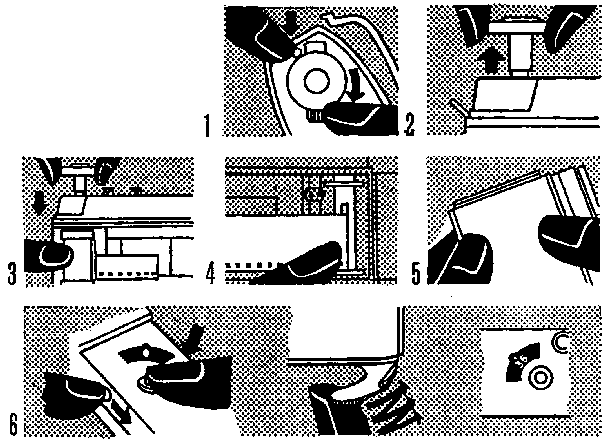
The above sequence shows mainly the current models; older Retinas vary in detail, affecting certain steps (see green pages).
1. Open the camera back.
2. Fully pull up the rewind knob.
3. Insert the cassette and push back the rewind knob.
4. Attach the film to the take-up spool.
5. Close the camera back.
6. Set the film counter and make two blind exposures.

For unloading:
1. Set the camera for rewinding.
2. Rewind the film.
3. Open the camera back and take out the cassette.
Unloading
After all exposures have been made (the number of exposures still left on the film is automatically shown on the film counter), unload the camera.
- Set for rewinding. This disengages the transport sprocket in the camera.
- Rewind the Film. Rewind the film into its original cassette by turning the rewind knob in a clockwise direction. Winding becomes distinctly easier the moment the film is fully wound back.
- Open the camera back, explained under Loading, No.1.
- Remove the cassette, then close the camera back (Loading, No.4), or reload with a new film.
Cutting off Exposed Lengths
If a film which is only partly exposed has to be processed, set the shutter for the next exposure and in the darkroom or in complete darkness Cut off with a pair of scissors the frame which lies in the film aperture. Retrim the remainder of the film (see p.21), fix it again on the take-up spool, and close the camera. It is ready for the next exposure once the film counter has been set four numbers forward (the amount of film lost through cutting and re-loading).
The re-inserting can be done in daylight. In this case a total of about 6 frames are lost, for, after inserting and closing, two blind exposures have to be made to wind on the film length which was exposed to the daylight.
Changing Partly Exposed Films
To replace a partly exposed film by another one. for instance if you want to take a few colour photographs in between some black-and-white shots, proceed as follows:
- Check the number of exposed frames on the film counter.
- Rewind the film, but stop immediately you feel a slight resistance. This resistance comes from pulling the film end from the take-up spool. If the film is to be reloaded again, you must not pull the whole film into the cassette, otherwise the film end would have to be extracted by opening the cassette in the darkroom for subsequent re-insertion into the camera.
- Unload the re-wound film and note the number of exposures taken on the beginning or the film. Now you can load the camera with any other type of film.
When reloading, load the partly exposed film in the usual way (p.16). Then keep pressing the film release (not the shutter release) and advancing the film until the film counter has reached the No. of the frame you noted before. To be on the safe side it is advisable to allow one more frame to pass.
The rest of the film can now be exposed in the usual way.
The Film Release
Most Retina models have a film release, in the form of a small button (a lever on old models) on top of the Camera behind the shutter release. Apart from its use in changing partly-exposed films, the film release helps in rectifying any jamming which may lock the mechanism of the rapid winder. Simply depress this button to clear the winder, without losing a frame or risking a double exposure. If pressure on the film release does not release the winder, this automatically indicates that the end of the film has been reached. In that case re-wind the film.
Double Exposures
On most Retina models the release lock prevents accidental double exposures. To make a deliberate double exposure for special effects, depress the reversing button after the first exposure, and keep it depressed while tensioning the shutter with the rapid winding lever. The film then remains in position for a second exposure on the same frame. The film counter, however, indicates one frame more than you have in fact exposed.
Other Film Packings
In addition to standard cassettes, 35 mm. film is also available in various loose packings for loading into cassettes. This is a much cheaper way of using film as you do not have to buy a new cassette every time with the film. The following packings are available:
DARKROOM REFILLS are lengths cut and trimmed for 36 exposures and have to be loaded into a cassette in total darkness (e.g. in a darkroom, a really well darkened room at night or a light-tight changing bag).
DAYLIGHT REFILLS are cut and trimmed lengths for 20 or 36 exposures which are wound on to a centre spool (as used in the cassette) and covered with a black paper leader strip to allow loading of a cassette in daylight.
BULK FILM is supplied in lengths of 18 to 200 ft., and is the most economical way of using film. A suitable length is cut off to be loaded into a cassette in total darkness. Working in total darkness for loading darkroom refills or bulk film is not difficult. It is, however, advisable to practise filling with a dummy film first in daylight before starting the darkroom work.
Handling, Winding and Trimming the Film
When handling the actual film, particular care must be taken not to touch its emulsion (matt) side. Always handle it and wind on to the centre spool of the cassette by holding the film by either side of its edge, preferably between thumb and index finger. At the same time, it is of no less importance that the spot on which the loading is done should be perfectly dry, clean and dust free.
When using bulk film in loading cassettes, the edge of the workbench can be marked with notches or drawing-pins to indicate various distances, let us say for 12, 24, 36 exposures of film. This considerably simplifies the measuring of film lengths in the darkroom.
LENGTH OF FILM REQUIRED FOR ANY NUMBER OF EXPOSURES
| Number of Exposures
| Length of Film Required
| Number of Exposures
| Length of Film Required
| Number of Exposures
| Length of Film Required
|
| in. -- cm. |
| In. -- cm. |
| In. -- cm.
|
| 1 | 11¾ | 30 | 14 | 31¾ | 80 | 27 | 51 | 130
|
| 2 | 13¼ | 34 | 15 | 33 | 84 | 28 | 52½ | 133
|
| 3 | 15 | 38 | 16 | 34½ | 88 | 29 | 54 | 137
|
| 4 | 16¼ | 41 | 17 | 36¼ | 92 | 30 | 55½ | 141
|
| 5 | 17¾ | 45 | 18 | 37¾ | 96 | 31 | 57 | 145
|
| 6 | 19¼ | 49 | 19 | 39¼ | 100 | 32 | 58½ | 148
|
| 7 | 20¾ | 53 | 20 | 40½ | 103 | 33 | 60 | 152
|
| 8 | 22 | 56 | 21 | 42 | 107 | 34 | 61½ | 156
|
| 9 | 23¾ | 60 | 22 | 43¾ | 111 | 35 | 63 | 160
|
| 10 | 25¼ | 64 | 23 | 45 | 114 | 36 | 64½ | 164
|
| 11 | 26¾ | 68 | 24 | 46½ | 118 | 37 | 66 | 167
|
| 12 | 28½ | 72 | 25 | 48 | 122 | 38 | 67½ | 171
|
| 13 | 30 | 76 | 26 | 49½ | 126 | Including trimming
|
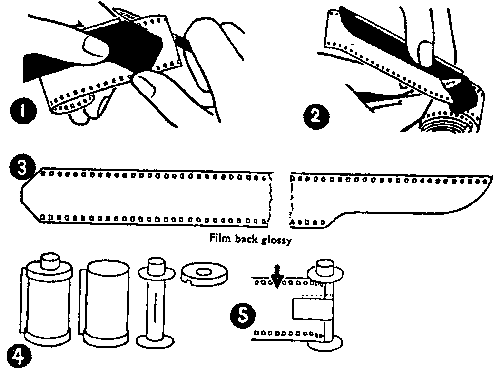
|
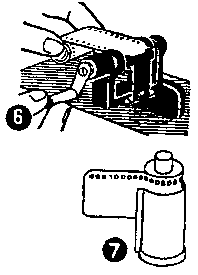
- Correct way of trimming the wedge-shaped end (which is fitted to the centre spool of the cassette) with a standard trimming template.
- Trimming of the curved cut with a standard trimming template.
- The appearance of the trimmed film, left wedge, right curved cut.
- The film cassette, its outer shell, centre spool and separate top.
- How to fix the film to the centre spool of the cassette.
- Winding the film with the mechanical film winder to the centre spool.
- Assembling the cassette.
|
The film ends need trimming. At the beginning of the roll of film make either a straight or wedge-shaped cut for the centre spool of the cassette and measure off the required length of film (see table, p.20). At the end of this make the curved cut for the take-up spool. The curved cut should start between the fifth and sixth bottom perforation -- when emulsion is towards you -- and must not go through a perforation hole.
The ready-cut film is now spooled on the centre spool of the cartridge or cassette. While winding on, hold the film only by its edges.
Also, take care not to press too hard on the film, and don't squeeze the film-ends when drawing through the hand. Failure to take the first precaution may result in fogging, while neglect of the latter precaution may give rise to peculiar kinds of exposure effects known as "lightning flashes". These are due to electrical discharges, and appear as dark, zigzag lines running from the edge of the film towards the centre of the picture.
Loading Standard Cassettes
The majority of cassettes consist of a centre spool which is in a shell with top and bottom cover. The film leaves the shell by a light-trapped slot. The centre spool can be removed from the shell by removing either top or bottom of the cassette, according to the construction of the particular container.
Most cassettes are actually intended by their makers to be used once only, and with the film originally supplied in it. However, provided they are reasonably robustly made, and the light-trapping velvet slot is in good condition, these cassettes can be reloaded many times, and will give perfectly satisfactory results -- if handled carefully.
Loading with Bulk Film or Darkroom Refills
Work in total darkness and prepare the film as described (p. 20).
- Open the cassette.
- Fix the film to the centre spool. If the centre spool is fitted with a film catch, thread the tapered end of the film into it. In cases where the centre spool is fitted with a spring, thread the end under it and fold it sharply back. If the centre spool is without any suitable fitting to hold the film, it has been proved best to wind a 1½ in. (4 cm.) piece of cellulose tape round the centre spool, so that on either side about ½ in. tape is used to secure the film.
- Wind the film on the centre spool.
- Insert the centre spool into shell, leaving the first 2 in. of film protruding through the light-trap.
- Close the cassette. Where top and bottom are originally fastened by the outside label, fix the top and bottom cover to the shell, preferably with a length of cellulose tape.
Loading with Daylight Refills
No darkroom is necessary, but work in subdued daylight or artificial light.
- Remove film wrappings and label of refill.
- Open the cassette.
- Introduce the refill into shell of the cassette; leaving the first 2 in. of paper-leader protruding through light-trap. The actual centre spool of the cassette is not needed.
- Close the cassette.
- Pull out the paper-leader and 2 in. of film.
- Cut off the paper-leader. Where top and bottom are originally fastened by the outside label, fix the top or bottom cover to the shell preferably with a length of cellulose tape.
|
Films and Filters
There are two kinds of films available for the Retina : black-and-white and colour.
Black-and-White Film
This produces a negative in which the colours and brightness range of the subject are translated into black and white. From it, prints or enlargements on paper or black-and-white transparencies can be made.
The black-and-white film used normally is panchromatic, that means that it is sensitive to all colours. There is a choice of several types differing mainly in sensitivity as well as certain other characteristics.
SLOW FILMS are of low sensitivity, requiring comparatively great exposure. Their main advantage is the extremely fine grain, permitting a high degree of enlargement without its granular structure becoming unpleasantly visible. Such films also yield images of the greatest sharpness. On the other hand, these slow films are not very suitable for coping with fast movement in other than exceptionally good lighting, nor for general work in poor light. Such films are rated at 40-80 ASA or l7-20 DIN.
MEDIUM SPEED FILMS still yield a reasonably fine grain with good gradation. They are the most suitable material for all-round photography, other than in poor light. These films are rated at 100-l60 ASA or 21-23 DIN.
FAST FILMS with somewhat coarser grain (still acceptable for reasonable degrees of enlargement) will cope with most light conditions including poor light and interiors in favourable conditions. This is the right film for the photographer who wants to be prepared for the unusual, to arrest fast movement with high shutter speeds, as well as shots in poor light. The speeds are 200-400 ASA or 24-27 DIN.
ULTRA FAST FILMS are primarily intended for high-speed sports shots in dull weather, interior snapshots in poor light, night photography and ill-lit stage pictures. These films are specialist types for conditions where normal materials are totally inadequate. They should not be used for general photography. The high speed is achieved at some cost in definition and graininess. Speed ratings range from 500-1300 ASA or 28-30 DIN.
There is a wide range of different makes of films in all speeds on the market. Their characteristics, apart from speed, vary slightly from make to make. It is safe to say that all well-known brands are reliable and good. The best film is the one you are used to. Professional photographers and advanced amateurs may find one or the other characteristics of a particular make, i.e. its gradation, granular structure, acutance, etc., of particular value for specific jobs.
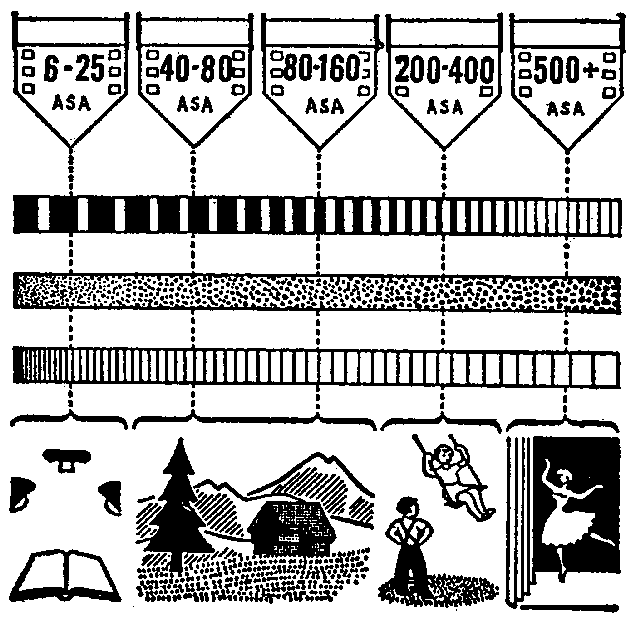
Generally speaking, low speed goes with greatest contrast, finest grain and highest resolving power and vice versa. The film speed in the top row points to the corresponding contrast, grain and resolving power. The contrast row shows (from left to right) how high contrast becomes medium and low as speed shows. The grain row shows (from left to right) how fine grain turns into medium grain with growing speed and finally the resolving power row shows the the decrease of resolving power (number of lines) with increase of film speed. The bottom row indicates the type of subjects for which films of the various speeds are best.
Colour Film
These films produce an image in colour after appropriate processing, corresponding directly or indirectly to the natural colours of the subject. From the practical point of view, colour film is as easy to use as black-and-white film needs a little more care in exposure. Processing is more complex and is often carried out by the film maker or specially appointed processing laboratories.
There are two basic types of colour film : reversal and negative.
Colour Reversal Film
This produces a colour transparency on the actual film exposed in the camera. This transparency held up to the light shows a positive image with all parts of the subject in their original colours. It can be viewed in a suitable transparency viewer with a magnifier or it can be projected in a slide projector to give a large and brilliant picture on a screen.
There is little doubt that the projected image is the most natural and best for showing colour.
Although the colour transparency is an end product, it can still be used to make:
(a) duplicate positive colour transparencies,
(b) a black-and-white negative which can then be used to produce black-and-white prints or enlargements,
(c) a colour negative for making colour prints and enlargements, as from colour negative film (described below),
(d) direct colour enlargements on colour reversal paper.
Colour prints on paper invariably show a loss of colour quality as compared with the original positive transparency.
For correct colour rendering, colour reversal films have to be carefully matched to the light by which they are to be exposed. Accordingly, most makes are available in two or more of the following types:
(a) daylight colour film (type D or T) which will give correct colour reproduction in daylight or with blue-tinted flash bulbs,
(b) artificial light type colour film which will give correct rendering by photoflood illumination (type A or K), or high-power tungsten light,
(c) flash type colour film (type F) which will give correct rendering with the normal clear flash bulbs.
Colour films made for one kind of light may often be used under different light conditions with the aid of a conversion filter as recommended by the manufacturer.
Different makes of colour film may yield transparencies of a slightly different characteristic colour quality, colour saturation and colour contrast. Which you prefer is very much a matter of personal taste, and you can only be recommended to try various makes to find the one which suits you best.
Colour Negative Film
On processing, this produces a colour negative which shows a negative image of the subject in its complementary colours; e.g. blue appears yellow, red appears blue-green and so on. These colours may sometimes be hidden under an overall orange or reddish tint.
The main purpose of the colour negative is the production of colour prints on paper. The quality is generally higher than that obtained from a positive transparency.
From the colour negative you can make:
(a) any number of colour prints in varying sizes,
(b) direct black-and-white prints or enlargements, in the same way as from a black-and-white negative.
(c) positive colour transparencies for viewing or projection.
Colour negative films are mostly suitable for exposure by any type of light, e.g. daylight, flash or photofloods. The necessary adjustment of the colour rendering is carried out during the printing stage. Manufacturers sometimes recommend conversion filters even with colour negative films. These mainly serve to simplify the subsequent correction needed in printing.
Colour Film Speeds
The majority of colour films, reversal and negative, are rated between 25 and 50 ASA or 15 and 18 DIN, which corresponds to a fairly slow speed for black-and-white material. A few films go up to 160 ASA or more for poor light conditions. Others may be as slow as 10 ASA or 11 DIN. As with black-and-white films, the slower types tend to yield improved image detail, especially with negative colour film, while the fastest emulsions may show slightly reduced colour saturation and image sharpness.
The Choice of Colour Film
Making your choice between colour reversal or negative film (in spite of the various uses that can be made of either type of material) remains an individual question.
First there is the way you want to see the result, as a colour print or as a colour transparency. The print has no doubt much to commend itself. It is easily shown, stored and carried about. The transparency calls for the aid of a viewer or projector.
Next, the cost of a colour print is about three times that of the transparency. This may at times be mitigated by the fact that from unsuitable negatives no colour prints need or can be made. The transparency user, however, has additional outlay in the form of a viewer or projector with screen (in most cases both).
A final point to consider is the quality. The transparency will record each colour and its brilliance in full. Held to the light or projected on a screen, the brightness range, which may be 100:1, is fully or almost fully retained. It shows colours brilliant with great depth and realism. The colour print can at its best only reflect four-fifths of the light falling on it and even the darkest tones reflect about one-twentieth to one-tenth, so that the full range is no more than 16:1. While the colour print is, by necessity, duller than the transparency, it is only fair to say that the eye soon adjusts itself to the reduced brightness range and subjects without great contrasts will be very satisfying.
From the point of view of convenience, reversal film has the advantage that it directly gives finished colour pictures of high quality and is still capable of producing colour prints as well. For the maximum versatility and control in print making, however, negative film is superior.
Filters for Black-and-white Film
By its nature, a black-and-white film can only translate colour values of the subject into tones of lighter or darker grey. Mostly these correspond fairly closely to the brightness of the colours, but do not of course differentiate between them. In certain cases the difference between the brightness of two colours may be so slight that both record in almost the same tone of grey.
There a filter helps by modifying the depth of one or the other colour, and so making it show up lighter or darker than it would normally.
The commonest example is the blue sky in a landscape, with white clouds. The blue is so brilliant (and the film is often excessively sensitive to it) that the clouds do not show up against it. By putting a yellow filter in front of the camera lens we can subdue or "hold back" the blue, so making it record darker in the final print. We can even go further and overemphasize the effect progressively with an orange or red filter; these darken the blue so much that the sky looks almost black for a really dramatic effect.
The same considerations hold for other filter effects. For instance, the film renders a red rose in the same tone of grey as the green leaves of the rose bush. With the colour contrast gone, the rose disappears in its surroundings. A green filter makes the rose darker and the leaves lighter; conversely a red filter will show up the rose as light against dark foliage. Scientifically, both filters falsify the tone rendering, but produce a more acceptable pictorial result.
In all these cases a filter lightens objects of its own colour, and darkens objects of its complementary colour. Apart from isolated instances in pictorial photography, such contrast control is very valuable in copying and scientific work (e.g. photomicrography).
All filters cut out some part of the light and thus, as a compensation, an increase in exposure time is necessary when using them. This is stated on most filters in the form of a filter factor indicating by how much (e.g. 2 times, 3 times), the exposure must be increased with that filter. The factors are approximate for they depend not only on the nature of the filter but also on the exact colour sensitivity of the film and on the colour of the prevailing light.
Filters for Colour Film
The normal yellow, orange and other filters for black-and-white film must never be used with colour films as they would give the picture a strong overall colour tint.
In daylight and with daylight type film, only two filters are ever required. One is a haze filter, almost colourless but for a slight straw tinge. It is usefully employed on hazy days and in high altitudes to avoid excessive bluishness of the colour picture, especially with distant landscapes, seascapes and near water. This filter does not call for any change in exposure. On dull days, a skylight filter compensates for the excessive coldness of the colour rendering.
Either filter is also useful for colour photography with electronic flash as it produces somewhat warmer tones.
Conversion filters are used if a colour film, balanced for one type of light, should be used in another type of light. The film manufacturers give specific recommendations, generally in the instructions with the film.
The Polarizing Screen
There are times when the judicious use of reflections will enhance the pictorial effect of the picture, but they are also frequently obtrusive and undesirable. Thus highly-polished subjects are difficult to illuminate successfully so as to obtain a true photographic rendering, since they will reflect too much light and so spoil the reproduction with a glare which obscures the detail. This difficulty can be overcome by the use of the polarizing screen.
It has the special property of suppressing so-called "polarized" light. Light reflections from glass, china, enamel, polished wooden surfaces, water, to a large extent are polarized and can, therefore, be almost extinguished by placing the polarizing filter in proper position over the lens. This screen will prove particularly useful when taking shop windows, furniture, photography of wet objects, etc.
The filter must be rotated in front of the eye to find out its best position on the lens and placed on the camera lens in this position. As the polarizing filter is slightly tinted, the exposure time should be increased, the factor being about three times.
The polarizing screen is, in addition, particularly useful in colour photography where it acts similarly to the yellow filter in black-and-white photography, i.e. it darkens a "milky" blue sky. The bluish colour cast obtained with diffused sky light is removed or at least appreciably reduced with the polarizing filter. The reduction or elimination of reflections through this filter is of course just as useful in colour pictures as it is in black-and-white.
The Retina polarizing screen is fitted with its own lens hood.
|
Exposure
Exposure means -- to expose the film in your camera to light. The dose of light any film needs to produce the right sort of image depends on how sensitive that film is to light. A fast film is more sensitive than a slow film.
Once your choice of film is settled, the basic condition of exposure is settled with it. You are now left with the problem of scaling the light you find in front of your camera to the amount your film needs.
Your job is to judge the light reflected from the subject you are about to photograph. Your grandfather as an amateur photographer used to take into account his geographical position, the time of the year, the hour of the day, the state of the sky as well as the tone of the subject itself, and by so adding one thing to another size up the light reflected from the subject. The experienced professional, of course, hardly ever worked that way. He just had a look and he knew.
Today a light meter or exposure meter does the same for any photographer. It takes a look, it measures the light and it lets you know.
In fact, it does more than that. It translates the light measured straight into terms of photographic exposure. It does so by presenting you with the choice of aperture numbers and shutter speeds, sorting them out in pairs.
Aperture and Speed
The aperture number or f stop controls the amount of light allowed to enter through the lens. These numbers run in a series: 2-2.8-4-5.6-8-11-16-22. Each higher stop number lets through half the light of the next lower number (next larger stop).
The shutter speed controls the length of time for which the lens is kept open to light. Shutter speed figures represent fractions of a second: 2 = ½ second, 4 = ¼ second...500 = 1/500 second.
The actual exposure is a product of these two: "how much" and "how long". A large amount of light striking the film for a short time may produce an image similar to that produced by a small amount of light striking the film for a long time. Hence the free choice from a series of balanced aperture-shutter combinations offered by your exposure meter: more or less open apertures paired with more or less quick shutter speeds, and more or less stopped down apertures paired with more or less slow shutter speeds.
Cameras of recent vintage combine these pairs, made up of aperture stops and shutter speeds, into single figures which are then called exposure values or light values. Once you set the exposure value suggested by the exposure meter both the aperture and the shutter speed move up and down in step against each other, and so keep the resulting exposure right at every combination.
With exposure meters built into the camera and coupled to cross-linked aperture-speed controls you may even be able to set the right exposure without looking up the number either on the meter or the camera. You set the exposure visually by following the swing of the needle in the meter and matching it with a pointer or a circle on the spot where the needle comes to rest. Certain shutters (e.g. Prontormat) are linked to the exposure meter in such a way that lining up the meter needle with an index mark automatically selects a correct aperture-speed combination. In that case, no choice of alternative settings is available; simpler operation is obtained at some sacrifice of versatility.
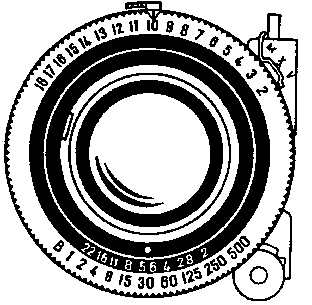
Left: The Synchro-Compur shutter of the Retina Ib to IIIC models with exposure value scale. All the aperture-shutter speed combinations paired off opposite each other correspond to the same exposure. Older versions of this shutter had the aperture scale placed next to the exposure value scale.
|
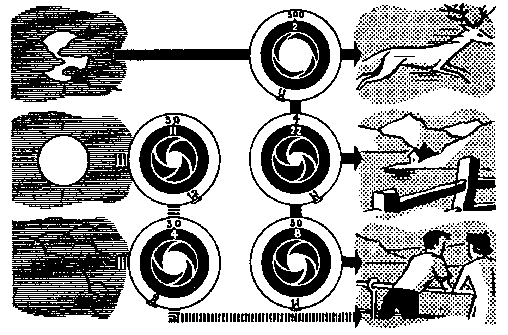
The aperture and speed on the exposure value shutter are coupled. With a given exposure value (e.g. 11), setting a fast shutter speed automatically opens the lens, while stopping down automatically sets a slow speed to keep the exposure constant (right). To alter the exposure for different light conditions, simply change the exposure value setting (left).
Choosing the Combination
But whether you work out the right exposure from an elaborate table or chart;
whether you are presented with a series of exposure values or pairs of aperture figures and shutter speeds;
whether you just set the exposure to the point shown by the needle in your meter;
or whether the meter does the job for you altogether -- you still have one decision to face: which aperture-shutter combination to choose for any given shot. Paradoxically enough, they all are right yet one is better than the other.
Why should it be so?
Because both the aperture and the shutter also have secondary functions and effects.
The aperture not only controls the amount of light that is allowed to pass the lens -- it also has a bearing on how much of the image will be sharp.
The shutter, in controlling the length of time for which the light strikes the film, will inevitably record any movement that happened during that time as a slight or greater blur.
So you are left with three things to think of:
How fast is the action you want to catch?
How much of the scene in front of the lens has to be sharp?
Is the light good enough to go by either?
If there is fast action you have to choose and pre-set an appropriately fast shutter speed (p.40) and then pair it with the stop you get by the cross-coupled controls or from your meter.
If the scene is to be sharp from a point close to the lens to some other point well away from it, you should choose the stop that will yield the necessary depth of field (p.41) and then pair it with the shutter speed necessary for the correct exposure.
If the light is very poor, the chances are that you may not be able to cope with either extremely fast or particularly deep subjects. Yet your choice in putting shutter speed or depth of field first should still be governed by what you value most about the picture you propose to take.
Exposure nowadays is no problem at all. You can arrive at the right exposure by guessing it, measuring it, or just leaving it to the camera. But to hit it off in such a way that it will produce the picture you want is still a matter of intelligent judgement. Only the scale-less shutter relieves you even of this decision.
Time Exposures
When the light is very weak, especially when you have to use a small stop, even the slowest shutter speed of 1 sec. may be too short. In that case, you need time exposures. Set the shutter to B and press the release button. The shutter now remains open for any length of time until you let go of the release button.
For such time exposures, the camera must be mounted on a firm support such as a tripod.
It is safest to release the shutter with the help of a cable release to avoid shaking the camera. This release screws into the bush in the centre of the body release button (or elsewhere on earlier models -- ‡).
For long time exposures, where the shutter is to remain open for longer than you can conveniently keep the release depressed, use a cable release with a lock. To make the exposure set the shutter to B, press the cable release plunger with the locking plate lifted. The shutter will now remain open until the locking plate is depressed. On cable releases with locking screws, tighten the screw on pressing the plunger and undo the screw to close the shutter.
The Self-timer
The Retina models since 1954 carry a delayed action release or self-timer. This is usually controlled by the same lever as the flash synchronization (p.44). When you press the release button with the self-timer in operation, the shutter only goes off after a delay of 8-10 seconds and you have time to take your place in your own picture. The camera must, of course, be mounted on a tripod.
EXPOSURE METER READINGS
|
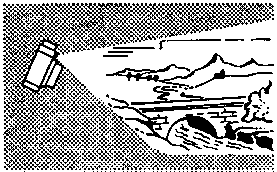
For normal readings. point the meter cell at the subject by sighting the latter in the viewfinder. But point the camera slightly downwards to exclude over-bright sky areas.
|
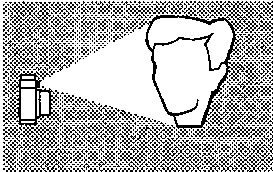
For more accurate readings. especially with very light or very dark backgrounds, go close to the subject so that the meter just takes in the subject itself.
|
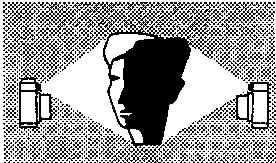
With contrasty subjects consisting of very bright areas and very deep shadows, take separate close-up readings of the light and dark parts. Use a mean of the two for the exposure.
|
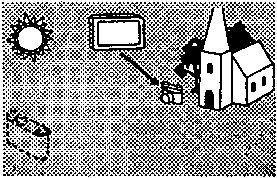
For incident light readings -- especially with colour film -- point the camera with the meter from the subject towards the camera position to be used for the exposure. For this reading fit the diffusing screen supplied with the camera over the exposure meter cell.
|
Using an Exposure Meter
To get the best results an exposure meter has to be used intelligently. This may look like a contradiction, since we have already said that it is an accurate light measuring instrument. But light from all parts of the subject -- highlights, shadows and middle tones -- falls on the meter, so the reading it gives us is an average one for the whole subject area.
Meters are scaled to suit typically average subjects -- i.e. subjects with average areas of light, dark and middle tones. So if you point the meter at a subject of this kind, the exposure reading will be correct.
But if the subject is not average -- if there are large highlight areas and little shadow, or large shadow areas with few highlights -- then you have to modify the exposure reading to obtain the best results.
So there is more to using a meter than just pointing it at the subject and accepting without question the reading indicated.
The usual method of using a meter is to point it directly at the subject. This gives the correct exposure reading provided the subject has an average mixture of highlights, shadows and middle tones. But if there is a large bright area, or a large dark area, the best method is to go near to the main subject and take a close-up reading. For example, if the subject is a figure against a white or dark background, by going closer you will reduce the amount of background affecting the meter and therefore get a reading in terms of a more average subject, which is what you want.
For some subjects you can take a reading from really close up, aiming the meter at the part of the subject that you want to make sure has optimum exposure. For instance, many photographers take a close-up reading of the sitter's face in portraiture; out-of-doors you can take the reading from the back of your hand instead of going up to the subject.
If you cannot go close up to a subject that needs a close-up reading, then try to find something near at hand that is similar in tone to the subject, and take a reading from this.
When taking readings of general scenes including a good deal of sky, you have to tilt the meter down slightly to reduce the area of sky "seen" by the meter. The sky is a bright highlight, and by tipping the meter down to exclude some of it, the subject becomes "average" in tone range.
Open views, such as distant landscapes, usually have very light shadows, so you can give a shorter exposure than the meter indicates. It is usual to give half the exposure -- i.e. use double the shutter speed, or use one stop smaller.
INCIDENT LIGHT MEASUREMENT. Another method of assessing exposure is to measure the strength of the light falling on the subject instead of that reflected by it. But if you point the meter straight at the light you get a much higher reading than if you point it at the subject. So the light has to be cut down for the meter to indicate the correct exposure. This is done by fitting a white diffuser supplied with the meter over the honeycomb cell. The diffuser is designed to reduce the light by just the right amount. It also serves another important purpose, and this is to ensure that the meter includes all the light falling on the subject over an angle of almost a full 180º.
The incident light method is particularly useful for reversal colour films, and for subjects with contrasty backgrounds when it is impossible to take a close-up reading.
To take a reading, the method is simply to turn your back on the subject and point the meter in exactly the opposite direction. If the main light -- say the sun -- is coming from the side, don't just partly turn round and point the meter at this; turn round completely, and let the main light strike the meter at the same angle at which it strikes the subject.
If the light on the subject is different from that on yourself at the camera position (say if the subject is in the shade, and you are in the sun), you must then go up to the subject and take the reading, pointing the meter towards the camera position.
AGAINST THE LIGHT subjects are extreme cases of non-average tone range. The main lighting becomes a very bright highlight in the field of view, so if you point the meter straight at the subject it will indicate too short an exposure and give you a silhouette effect in the final picture.
This is all right if you want a silhouette. But if you want correct exposure for the subject, you should either take a close-up reading, or take a reflected light reading from the camera position and give four to eight times the exposure indicated.
COLOUR FILMS have little exposure latitude, so particularly careful reading is advisable. The meter is used in the same way as for black-and-white films.
Because of the importance of the highlights, if you are using a meter from the camera position for an against-the-light shot, it is best to only double the reading, and not multiply it four to eight times as recommended for black-and-white negative films.
Shutter Speeds and Movement
The actual shutter-speed you need within a series of available aperture speed combinations is governed by considerations of camera steadiness as well as of subject movement.
An unsteady camera hold results in camera shake, to which a small and light instrument such as the Retina is particularly liable. Even the slightest shake will result in inferior definition of the negative. Practical experience goes to show that 1/125 sec. is safe, while you have to hold the camera particularly steady when using 1/60 or 1/30 sec. Where lighting conditions make even longer exposure times essential and there is no subject movement, either support the camera on a tripod, or look round for extra support for your elbows and hands -- e.g. a wall, railing, etc.
The shutter speed required to arrest movement depends of course primarily on the speed with which the subject moves. Remember, however, that parts of the subject (e.g. the legs of a runner) may move faster than the subject as a whole; you may sometimes have to compromise and show such parts slightly unsharp. Often that is not a serious fault, as slight blurring -- provided the main part of the subject is sharp -- helps to emphasize the impression of movement.
Other factors to consider are the distance of the subject -- the farther away, the less noticeable the movement blur; the focal length of the lens -- a long-focus lens in effect brings the subject nearer; and the direction of the movement. Objects moving across your field of view blur more than if they are approaching or receding.
The most convenient way of allowing for all these factors with the aid of a simple table (p. 53).
Aperture and Depth of Field
When you focus the Retina on a given object, the image of that object will be really sharp on the film. Things nearer or farther away will be gradually less and less sharp, until they are noticeably blurred. The range of distances over which objects are still acceptably sharp, before you do notice the loss of definition, is known as the depth of field.
You can control the extent of this sharp zone by the lens aperture. As you stop down the lens, the zone of sharpness grows in both directions; as you open up the lens, its depth decreases.
You can obtain the actual zone of sharpness at various apertures and distances from depth tables but in practice the most convenient way is to use the depth of field indicator -- this is a special scale of aperture numbers marked opposite the distance scale. There are two sets of such numbers from the largest stop (f1.9, f2 or f2.8) to the smallest (f22) on each side of the focusing index (the mark that indicates the distance to which you have set the lens). On early Retina models the indicator is a rotating disc fitted to the camera top.
At any distance setting, the distance figures opposite each pair of aperture numbers on the depth of field scale give the near and far limits of sharpness. For example, at 8 ft. you may find the two stop values 5.6 on the scale (f5.6) opposite about 7 and 10 ft. -- so you have a sharp zone from 7 to 10 ft. At f2.8, the distances opposite the stop values 2.8 may be 7½ and 8¾ ft. respectively; at f11 you might get a sharp zone from 6 ft. to 12½ ft.
You will also notice that the depth of field is greater at far distances than at near ones. At 5 ft. and f5.6 the sharp zone only covers from about 4½ to 5¾ ft. -- less than 1½ ft. altogether -- against nearly 3 ft. at the 8 ft. setting.
Two more points on depth of field.
First, the depth obtained depends also on the focal length of the lens. Short focus lenses yield more depth and tele lenses less depth. That is why the alternative lens units of the Retina • have their own depth of field indicator.
Secondly, the sharp zones obtained by the indicator or tables are based on a somewhat arbitrary assumption of how much blurring is acceptable. So depth of field data for different cameras with the same lens may not always agree, and you are also quite safe in rounding off figures obtained from such data. And if you intend to make realty big enlargements from your negatives, you can use stricter standards of sharpness by simply stopping down the lens by one stop.
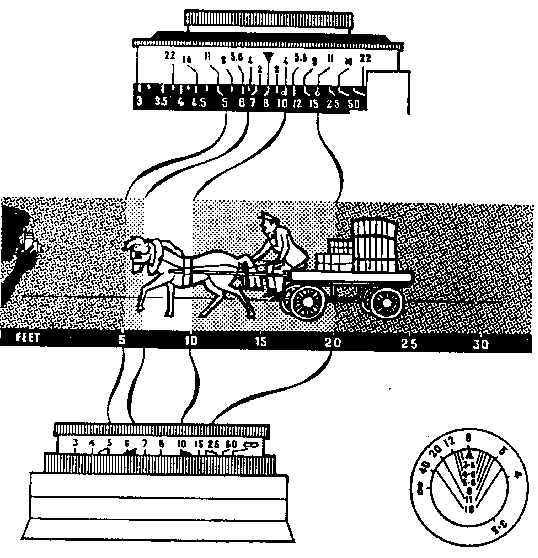
The depth of field scale shows clearly how much of the subject will be sharp at any given distance and aperture. The figure opposite the triangular index mark (top) is the focused distance -- in this case 8 ft. The figures to either side of the index mark represent aperture settings. To read off the depth of field, simply look up the distance figure opposite the left-hand and right-hand aperture figures in use. For example, at f4 the depth of field extends from about 6½ ft. to 10 ft. Using a smaller aperture increases the depth of field; thus at f11 the sharp zone extends from 5 ft. to about 20 ft.
On the Retina S models two pointers automatically show the depth of field zone (bottom) and are coupled with the aperture setting so as to move together or apart as you change the lens aperture.
Older Retina models have a depth of field calculator in the form of a disc (bottom right); this works in much the same way.
Zone Focusing
With action subjects and similar occasions where you want to shoot quickly, determining sharp zones even with the depth of field indicator wastes too much time. There you need prepared settings covering given near and medium distance ranges that you can easily memorize and set on the camera. The focusing zone table (p.53) gives such settings : then you only have to worry about keeping the subject within that zone while you shoot.
With landscapes and views you sometimes need depth from infinity to the nearest possible point. Thus by stopping down to f8 and focusing on 20 ft. you get a realty extended zone from infinity down to about 10 ft. But don't use this setting if you want the maximum sharpness in the far distance; in that case focus on infinity.
|
Flash with the Retina
Flash is an efficient light source where no or insufficient daylight is available such as at night, indoors, etc. In the flashlight you carry you own private "sun" with which you can illuminate your subject or scene at any time and place.
THE FLASH BULB is similar to a small electric bulb. However, when current passes through it, it lights up in an intense flash lasting usually about 1/40 to 1/60 sec. Each bulb will flash only once and has to be discarded afterwards.
The flash bulb is inserted in a flash gun and the current of the battery fires the bulb, while a reflector fixed behind the bulb makes sure that all the light is directed towards the subject. Most flash guns incorporate a capacitor unit which increases the reliability of firing, even when the battery is nearly exhausted. The shutter speed, provided it is slower than 1/50 sec., has no effect on exposure, since the flash is shorter than the exposure time.
Most flash bulbs are available with a clear glass bulb (for black-and-white and negative colour film and for type F reversal colour film) or with a blue-tinted bulb (for daylight type reversal colour films). The blue bulbs can also be used for fill-in lighting by daylight with any type of colour film.
ELECTRONIC FLASH UNITS utilize the discharge of a high-tension capacitor through a flash tube. The power is derived from an accumulator or battery (there are also models working from the mains electricity supply). The electronic flash outfit is rather bigger and heavier than the flash bulb outfit, its comparative light output equals a small flash bulb and its initial cost higher.. On the other hand, anything from 10,000 to 25,000 flashes are obtained from one tube. The flash duration is extremely short (1/700 to 1/2000 sec.) and will arrest the fastest movements. The cost of an individual exposure is negligible.
Electronic flash is suitable for black-and-white and negative colour film and also for daylight type, reversal colour films. It can also be used for fill-in lighting by daylight.
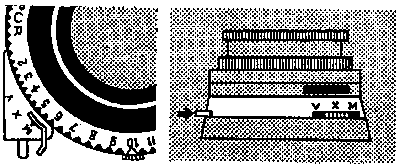
|
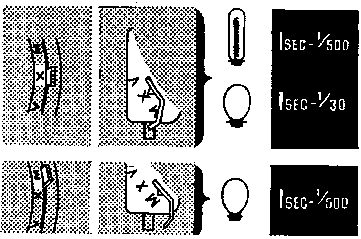 Above left: The synchronizing lever next to the flash socket of the shutter on current folding Retina models selects the type of synchronization (X or M). V is the self-timer setting. On Retina S models (above right) the lever can only be moved after pushing in a small locking lever.
Above left: The synchronizing lever next to the flash socket of the shutter on current folding Retina models selects the type of synchronization (X or M). V is the self-timer setting. On Retina S models (above right) the lever can only be moved after pushing in a small locking lever.
|
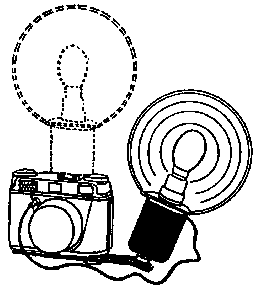 Above: The X-setting will synchronize electronic flash at all shutter speeds, and ordinary flash bulbs at up to 1/30 sec. At the M setting, flash bulbs can be used at any speed up to 1/500 sec., but electronic flash is not synchronised at all.
Above: The X-setting will synchronize electronic flash at all shutter speeds, and ordinary flash bulbs at up to 1/30 sec. At the M setting, flash bulbs can be used at any speed up to 1/500 sec., but electronic flash is not synchronised at all.
Left: The Kodablitz flash gun for the Retina fits either directly on the camera in the accessory shoe, or it can be fitted on a bracket which screws into the tripod bush. The cable for the flash gun plugs into the flash socket of the camera to complete the synchronizing circuit.
|
How to Use Flash
The Retina shutters supplied since 1950 are internally synchronized for use with flash bulbs and electronic flash. The cable from the flash gun is plugged into the flash socket of the Retina. On releasing the shutter, an electric circuit is automatically closed through the flash socket, setting off the flash at this moment.
The first types marketed up to 1951 and again from 1962 on have a non-adjustable flash contact which has the characteristics of the X-synchronization described below. On the Retinas 1952 to 1962 a synchronizing lever protrudes on the side of the shutter.This can be set to X or M.
WITH THE SYNCHRONIZING LEVER SET TO X the shutter closes the flash circuit at the moment when the blades are fully open. Therefore, electronic flash is synchronized at any shutter speed to 1/300 or 1/500 sec. This setting may also be used with flash bulbs with short firing delay (i.e. bulbs which require only 4-6 milliseconds -- thousandths of a second) to reach the peak of their light output with the shutter set to 1/60 sec. With other bulbs, the fastest usable speed is 1/30 sec.
WITH THE SYNCHRONIZING LEVER SET TO M the shutter closes the flash circuit 16-18 milliseconds before the shutter blades open to allow for the firing delay of most average flash bulbs. This setting is suitable for normal flash bulbs at all speeds up to 1/300 or 1/500 sec. The M-setting will not synchronize electronic flash or short-delay bulbs.
WITH THE SYNCHRONIZING LEVER SET TO V (not on early models of the Retina) the delayed action release for self-portraits is brought into action. At the same time the shutter works with X-synchronization. This means that you can work with delayed action and flash at X-synchronization; delayed action with M-synchronization is not possible.
Exposure Guide Numbers
There is a convenient way of working out exposures with flash, and this is by means of a guide number. When you buy flash bulbs you will always find the guide number for any speed of film printed on the packet.
To find the correct aperture to use, divide the guide number by the distance between the flash and the subject. For instance, suppose you find that the guide number of the bulb with the film in use is 160. If you then want to take a photograph at a distance of 10 ft. from the subject, divide 160/10 = 16. Therefore, the correct aperture to use is f16. Alternatively, if you want to use an aperture of f8 for any reason, then the correct flash distance is 160/8 = 20. So the flash must be 20 ft. from the subject.
So far we have assumed that the exposures have been for average shots without much subject movement. For these a shutter speed of 1/30 sec. is long enough to utilize all the light emitted from the bulb. On the other hand, to arrest fast movements a faster shutter speed is required, such as 1/125, 1/250 or even 1/500 sec. With each of these speeds a different guide number is needed (usually printed on the flash bulb packet) to determine the correct exposure. They allow for a wider aperture to compensate for the fact that at fast shutter speeds some of the light emitted from the bulb is lost.
|
Camera Care in Tropical Climates
High and widely varying temperatures with low humidity, as occur in desert regions and dry seasons, and very high humidity in rainy seasons, call for special precautions to protect the life and continued good performance of the camera. These conditions also cause the growth of moulds on organic matter. Sand, dust and insects may present problems.
The camera should be kept dry and clean. Leather parts should be wax polished, metal parts lightly greased. Never leave the camera unnecessarily exposed to heat. Always keep it in its case. With the non-folding Retina models, the lens should be covered with a lens cap when not in use; additionally, it should be protected by a colourless filter. Outer lens surfaces have to be kept clean, dirt and grit removed with an air-blower and by tapping. Wipe the lens surface with cotton wool or open mesh fabric (butter muslin), when required.
Store photographic equipment in an airtight metal box or a tin which should be sealed with adhesive (e.g. medical) tape. In a humid atmosphere, add some desiccating agent, e.g. silica gel.
Condensation on the lens may occur when the camera is moved from a cool place into humid heat; this has to be removed before use and the whole camera carefully wiped before re-storing.
Films should not be kept longer than six-months in their original airtight tins (tropical packing) at continual temperatures of 90ºF (32ºC). At continual 100ºF (38ºC), the life of most films is limited to a month or two. Keep films for as short as possible a time in the camera.
Films should be processed as soon as possible after exposure -- within a week or two or, in very hot humid climates, within a few days. Keep the film in an airtight container with desiccant (to absorb moisture). If possible, keep in a refrigerator, but only if you can dry out the exposed film and the container is sealed.
|
Using Alternative Lenses
The field of view covered by the standard lens is ideal for the majority of subjects. Occasionally, however, a greater or reduced field of view has distinct advantages. Some Retina models have an interchangeable lens system providing alternative focal lengths • for such occasions.
Wide-angle Lens
A wide-angle lens is a lens of shorter focal length; it sees and reproduces more of the subject in front of the camera than does the standard lens.
Such a wide-angle lens has definite advantages in cases where the practicable distance between camera and subject is limited and insufficient for the standard lens to record the subject in its entirety. The wide-angle lens is, therefore, primarily used for architectural photography and interiors.
In view of its short focal length, the depth of field covers a particularly wide zone, even at full aperture. It can, therefore, be employed with advantage as a quick-shooting lens for general purposes where accurate focusing or distance-setting would be inconvenient (e.g. insufficient time).
To get a large image, even of a near object, you have to go really close to it. Near objects then tend to dwarf more distant ones, and the resulting picture shows pronounced perspective effects, In this way, the wide-angle lens can be used to emphasize perspective.
Telephotography
A tele lens on the other hand has a smaller angle of view than the standard lens. It is of longer focal length, it reproduces less of the subject in front of the camera than the standard lens does, but on a larger scale.
Such a lens is particularly suitable for subjects that are difficult to approach closely such as animals, children, architectural detail, sports events, etc. In photographing distant views without near foreground, it brings the subject nearer. It also permits a greater camera-to-subject distance in portraiture, producing a more pleasing and subdued perspective. At the same time, its lesser depth of field concentrates definition on the portrait, avoiding a sharp background which would detract from the main object.
Focusing
Wide-angle and telephoto lenses are focused with the aid of the built-in camera rangefinder. In the following Retina models the distance read off has to be transferred manually to an auxiliary focusing scale; with the Retina IIIS, both wide-angle and tele-lenses are automatically coupled to the rangefinder in the same way as the standard lens.
Viewing
The field of view obtained with the wide-angle or tele lens is shown by the additional image frames visible in the reflected frame finder. Earlier Retina models with interchangeable lenses have no alternative image frames; separate accessory viewfinders are then used.
|
The Retina IBS, IF and IIF
These models have rigid body design, with built-in photo-electric exposure meter coupled to aperture and shutter speed. The exposure needle is visible in the brightline viewfinder, which has parallax correction marks. A depth of field indicator shows the zone of sharpness. The film transport lever in the camera base advances the film and tensions the shutter. An accessory shoe is fitted to the camera top. The shutter is X-synchronized and has a built-in delayed action release. The lens is the Retina Xenar 1¾ in. (45 mm.) f2.8, non-interchangeable.
THE RETINA IBS is fitted with the Compur-Special shutter speeded from 1 sec. to 1/500 sec. and B. Focusing is by light signals appearing in viewfinder.
THE RETINA IF has a built-in transistor flash gun, folding away into the camera body when not in use. The shutter is the Prontor 500 LK with speeds from 1/15 sec. to 1/500 sec. and B.
THE RETINA IIF is as model IF, but is fitted with a built-in range-finder, coupled to the lens, and the shutter is the Compur-Special, speeded from 1 sec. to 1/500 Sec. and B.
ALL MODELS ACCEPT 32 mm. filters (screw-in) and 32 mm. push-on lenshood.
FOR CLOSE-UP WORK at less than 38 in. the close-up lenses NI and NII permit focusing between 38 and 12 in. For even closer work three "R" lenses are available for a focusing range between 11 and 7 in.
OTHER ACCESSORIES include table stand, copying stand, right angle finder, microadaptor.
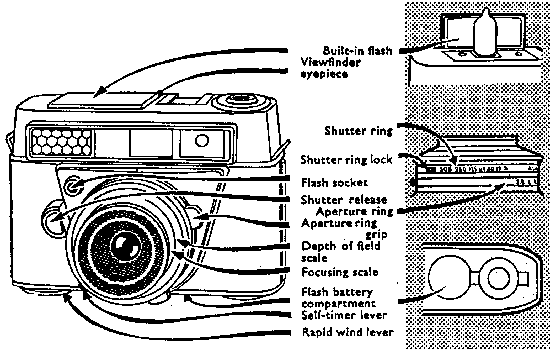
The film counter is built into the camera base to make room for the flashgun in the top. The rewind knob is flush with the camera top and springs up on depressing and turning the knob slightly. Film speeds are set on the shutter ring. Focusing is by front-cell focusing mount. On the IIF the focusing movement is connected with a built-in rangefinder. The focusing scale of the IF has zone settings in the form of symbols. The exposure meter needle is coupled with the aperture and shutter speed setting rings. You set the shutter speed then turn the aperture ring to line up the meter needle in a centering mark.

Shooting with the Retina IF and IIF. From left to right: Advance the film and tension the shutter with the rapid winding lever; set the shutter speed; turn the aperture ring to bring the meter needle in line with the centering mark; focus the lens (with the coupled rangefinder on the IIF); press the release button to expose.
Loading
- Open camera back.
- Insert the film cassette.
- Fix the film onto the take-up spool.
- Close the camera back.
- Set film counter.
On IBS push the setting knob beside the viewfinder eyepiece in the direction of the arrow until the diamond mark appears in the counter window in the top plate. (For a 36-exposure film use diamond mark between 36 and 1, for a 20-exposure film between 20 and 24.)
On IF and IIF setting knob and counter are in the base of the camera, but the handling is the same as described above for IBS. The film counter indicates the number of exposures still available in the camera.
- Make two blind exposures.
- Set the film type indicator to act as a useful reminder. Set the rewind indicator spring (do not pull it out) and hold it; turn the inner knurled ring until the black dot points to the symbol for the type of film loaded into the camera. The symbols represent:
- diamond mark (half white, half black) = black and white film.
- colour with sun = daylight colour film.
- colour with light bulb = artificial light colour film.
- Set the film speed. The film speed in ASA or DIN must be set by depressing the locking lever beside the film speed scale behind the shutter rim and turning the rim itself until the red dot shows to the appropriate ASA or DIN value.
Unloading
Set for rewinding by depressing the reversing button in the base of the camera.
- Rewind film. Let rewind knob spring up (do not pull it up) and turn it in the direction of the arrow until the reversing button stops to rotate. This is easily noted by the black dot near its rim.
- Open camera back.
- Remove cassette after fully pulling up the rewind knob.
Shooting
- Work the film transport by swinging out the rapid wind lever in the camera base as far as it will go, and let it spring back.
- Set the exposure time by turning the shutterspeed ring to the required speed, e.g. for average outdoor subjects to 1/60 sec., with a fair amount of movement to 1//125 sec., and faster movement 1/250 sec. or even 1/500 sec.
- Set the aperture by turning the aperture ring while looking through the viewfinder until the needle is centred in centre mark in the base of the bright line frame.
- Focus and determine picture area.
In model IIF set the distance with the built-in rangefinder by turning the lens mount until the two images in the centre of the viewfinder coincide.
In the model IF turn the lens mount to bring the desired distance figure corresponding to the subject distance opposite the large black arrowhead. For rapid focusing use the three zone-focus settings which are engraved on the distance scale. Portrait head = near range; Group = middle distances; and Landscapes = far distances.
The model IBS is similar to IF above. For rapid focusing the symbols are replaced by dots: • = near range, •• = middle distance, ••• = far distances. These dots appear also in the top of the brightline when looking through the viewfinder, permitting check of correct distance settings.
- Release the shutter gently by depressing the lever on the front of the camera.
Special Controls
FOR TIME EXPOSURES turn the shutter speed ring to B ( = brief time). A cable release screws into the release socket which is in the top plate of model IBS, and the shutter rim of models IF and IIF
THE DELAYED-ACTION RELEASE for self portraits is built into the shutter and brought into action after operating the film transport-by pushing the small lever on the shutter run sideways as far as it will go.
FLASH EXPOSURES Set shutter to 1/30 sec.
WITH MODEL IBS connect the cable from the flash gun to the flash socket on top of the front plate of the camera.
WITH MODELS IF AND IIF with built-in flash push the flash knob beside the viewfinder eyepiece in the direction of the arrow and the flashgun will spring up. This flashgun will accept AG1 flash bulbs. Place flash guard over gun when taking close-up pictures. After exposure, remove guard and eject bulb by pushing the flash knob The flash is fed by a Mallory PX625 battery (life approximately 2 years) which is housed in the base of the camera. To change, open battery cover with a coin, turning anti-clockwise and insert battery with + sign inside.
|
The Retina IIS and IIIS
These models have rigid body design with built-in rangefinder which is combined with the viewfinder and coupled to the lens. A built-in photo-electric exposure meter is coupled with the aperture and shutter speed controls.
The shutter fitted is the Synchro-Compur with speeds from 1 sec., to 1/500 sec. and B for time exposures, cross-coupled with the aperture control. It has a built-in delayed-action release and is fully flash synchronized for bulbs and electronic flash.
An automatic depth of field indicator shows the zone of sharpness at any distance and aperture. The film transport lever in the camera base advances the film and tensions the shutter, An accessory shoe is fitted to the camera top and a film release button is provided.
THE RETINA IIS of 1959 is fitted with a 1¾ in. (45 mm.) Xenar f2.8 lens. The lens is not interchangeable. The large size viewfinder has a reflected image frame with parallax correction marks.
THE RETINA IIIS of 1958 has a 2 in. (50 mm.) Xenar or Ysarex f2.8, or a 2 in. (50 mm.) Xenon or Heligon f1.9, as standard lens. This is interchangeable, and can be replaced by wide-angle and telephoto lenses from 28 to 135 mm., all of which are coupled to the camera rangefinder. The brilliant-frame viewfinder shows the image frames for all focal lengths from 35 mm. to 135 mm.; for the 28 mm. ultra wide-angle a special finder is required. The image frames in the finder are coupled with the focusing movement for automatic parallax compensation. Each lens has its own depth of field indicator.
BOTH MODELS ACCEPT 32 mm. screw-in filters (60 mm. filters with the fl.9 lens). A round 32 mm. slip-on lens hood is available for model IIS, while model IIIS uses a rectangular bayonet fitting lens hood which is also suitable for the 35 mm. lens.
FOR CLOSE-UP WORK from 39 to 11½ in. a close-up rangefinder with supplementary NI,and NII lenses is available for both models (IIS No., 14414/3; for IIIS No., 14424/3). For closer work, the close-up attachment covers distances between 11 and 6 in. with a series of supplementary R-lenses. This can be used with the Retina IIIS with f2.8 lens (but not f1.9) and model IIS with an intermediate ring.
OTHER ACCESSORIES include a sports frame finder, copying stand, micro adaptor and table stand.
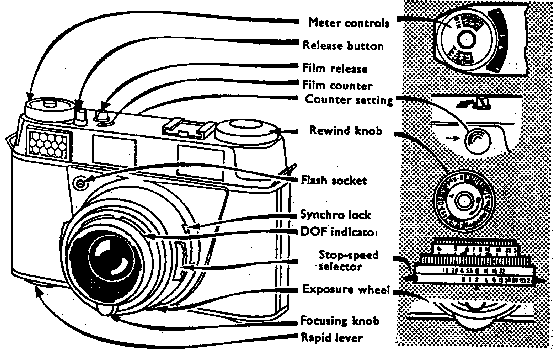
The exposure meter controls consist of a film speed scale on the top and a window in which the meter needle and setting pointer are visible. The latter is controlled by the exposure wheel. The release button incorporates a cable release socket. The film release permits advancing the film without making an exposure. The film counter can be set by a counter setting button in the camera back. The rewind knob incorporates a film indicator. The flash lever selects the type of synchronization or the self timer; it can only be moved after depressing the synchro lock. The depth or field indicator is automatically coupled with the aperture setting. The.shutter ring is cross-coupled with the aperture ring-combinations being set by the stop-speed selector. The exposure wheel is coupled both with the meter setting pointer and with the aperture ring. The lens catch releases the interchangeable lens. The rapid winding lever is in the camera base; next to it the reversing button disengages the transport for rewinding.
The above details apply to the Retina IIIS; the model IIS is almost identical in appearance. but does not have an interchangeable lens.

Shooting with the Retina IIIS and IIS. From left to right: Advance the film and tension the shutter with the rapid winding lever; sight the subject and turn the exposure wheel to align the setting pointer with the needle; select the appropriate aperture-speed combination you want; turn the focusing knob to make the rangefinder images coincide; expose by pressing the release button.
Loading
- Open the camera back.
- Insert the film cassette.
- Fix the film end to the take-up spool.
- Close the camera back.
- Set film counter. Depress the film release button and at the same time push the film counter setting button (on the back of the camera top) in the direction of the arrow. Repeat this until the diamond-shaped mark between the figures 1 and 36 (in the cut-out counter window) is opposite the notch in the upper edge of the film counter window. With a 20-exposure cassette set the film counter to the diamond mark at the figure 23. The film counter indicates the number of exposures still available in the camera.
- Make two blind exposures.
- Set the film indicator. Hold the rewind knob and turn the inner serrated ring until the triangular mark points to the type of film in the camera. (This acts as a reminder and does not affect the exposure.)
- Now set the film speed. Depress the button in the centre of the film speed disc of the exposure meter (above the meter cell). At the same time, turn the setting wheel protruding underneath the lens, until the cut-out near the rim of the speed disc indicates the correct ASA or DIN value of the film loaded into the camera.
Unloading
- Set for rewinding by depressing the reversing button in the bottom of the camera.
- Rewind the film by turning the rewind knob on the camera top in the direction of the engraved arrow until the reversing button ceases to rotate. This button has a black dot near its rim for easier observation.
- Open the camera back.
- Remove the cassette by pulling up the rewind knob.
Shooting
- Work the film transport by swinging out the rapid winding lever in the camera base as far as it will go.Then let it shoot back.
- Set the exposure. Before taking a reading with the exposure meter, pre-select a suitable shutter speed, e.g. 1/60 sec. for all general outdoor work. Turn the two black serrated keys on the shutter rim until the required shutter speed is opposite the triangular mark next to the shutter speed ring. The black figures on the shutter speed ring indicate fractions of seconds, 1 = 1 sec., 2 = ½ sec., 4 = ¼ sec., 60=1/60 sec., 125 = 1/125 sec., etc. (For green figures, see under Special Controls.)
Now take the exposure reading: Point the camera at the subject, keeping your fingers clear of the honeycomb window of the meter cell. Turn the setting wheel underneath the lens barrel until the yellow setting pointer (in the cut-out window) covers the thin white needle of the exposure meter. Look straight down on to the pointers.
As you superimpose the two pointers, the correct aperture figure automatically moves opposite the set shutter speed (against the triangular mark). The exposure is now correctly set.
The white lines (or triangles) visible in the corners of the meter window indicate the measuring limits. If the white exposure meter needle is outside these marks, the light is too strong or too weak for the measuring range of the meter.
As you turn the setting wheel you may sometimes feel a slight resistance. This indicates that you have reached the end of the aperture range; in other words, none of the apertures gives a correct exposure with the shutter speed originally chosen. By firmly turning the setting wheel further, you can, however, still superimpose the pointers. The new shutter speed then sets itself automatically.
- Select the aperture-speed combination. If you want to change the aperture or the shutter speed, turn the shutter speed ring by the two serrated black keys until the aperture or speed required is opposite the triangular mark; the exposure will remain correct. But do not force the ring past the limits of the aperture scale.
- Focus and determine picture area. Look through the viewfinder and watch the image especially in the bright centre circle. Turn the focusing knob on the front rim of the lens to make the double outlines in the centre circle fuse into one The camera is now set to the correct distance to the subject The image the camera will reproduce on the film is that outlined by the bright line frame.
On the Retina IIIS two frames appear, the inner being for the standard 50 mm. lens, the outer for the 35 mm. wide-angle. These frames -- as well as those which appear on inserting the long focus lenses of 85 mm. or 135 mm. -- automatically move during focusing to compensate for parallax.
On the Retina IIS the bright line frame shows the correct image from infinity down to 8 ft. To compensate for the finder parallax at 3½ feet, the two marks inside the frame indicate the upper limit of the field of view.
- Release the shutter gently.
Special Controls
FOR TIME EXPOSURES, set the index of the shutter speed ring to B (= brief time). A cable release screws into the release button.
The B setting is also obtained when the index points to any of the green figures to the left of the B setting. On releasing, the shutter will remain open as long as the release button is pressed down and closes as soon as the pressure on the release is removed.
The green figures indicate full seconds and are in fact the times for which you must keep the shutter open (by hand) at the corresponding aperture with any given exposure meter reading.
THE DELAYED ACTION RELEASE for self-portraits built into the Synchro-Compur is brought into action by moving the lever on the lower part of the shutter to V while pressing the small protruding lock on the left at the same time.
FLASH SETTINGS. For X or M-synchronization set the lever on the side of the shutter to X or M, at the same time depressing the small protruding lock on its left.
|
The Retina Automatic I, II and III
These models have a rigid body with built-in photo-electric exposure meter which is coupled to the aperture and shutter speed controls. This features an automatic setting system which selects aperture-speed combinations according to the available light.
The lens is not interchangeable. The large-size viewfinder has a reflected image frame with parallax correction marks, and also shows the focusing zone settings.
For focusing three zone settings are provided; marked by a series of black dots in between the normal figures of the focusing scale. A depth of field marking on the camera front indicates the actual focusing zones available at these settings for an aperture of f4.
The lens is a 1¾ in. (45 mm.) Reomar f2.8.
Model I does not offer a choice of combinations. The selection is continuous from 1/30 sec. at f2.8 to 1/300 sec. at f22, apertures and speeds being interlaced. The actual combination is not indicated, and there is no shutter speed or aperture (except for flash and time exposures) scale. The camera has no rangefinder. The shutter is a Prontormat and is X-synchronized for flash.
Model II is as model I, but has Compur shutter with speed scale 1/30 to 1/500 sec., permitting preselection of shutter speed. The lens is the four-element 1¾ in. (45 mm) Xenar f2.8.
Model III is as model II, but has a built-in coupled rangefinder.
The lens front of all models accept 32 mm. screw-in filters. A round 32 mm. slip-on lens hood is also available.
FOR CLOSE-UP WORK from 39 to 11½ in. a close-up rangefinder with supplementary NI, NII and NIIIa lenses is available (No. 14413).
OTHER ACCESSORIES include a sports frame finder, right-angle finder attachment, eyesight correction lenses, etc.
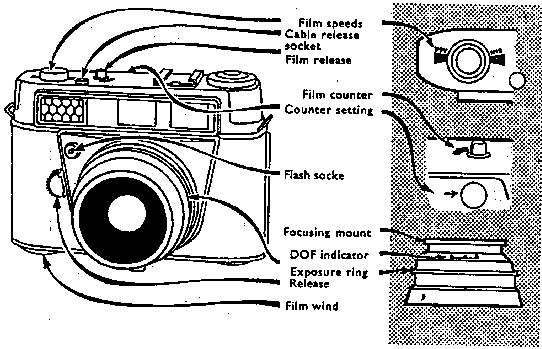
The film speed settings adjust the exposure meter to the speed of the film in the camera. A film type indicator is also fitted in the rewind knob. The cable release socket in the top of the camera takes a standard threaded nipple. The film release disengages the film lock at the end of the transport movement, to permit the making of blind exposures. The film counter is visible in a window on top of the camera and counts exposures backwards from No.36. The counter setting button in the camera back used in conjunction with the film release, sets the counter to its starting position when loading. The flash socket on the front takes standard co-axial plugs. As the shutter is X-synchronized, there is no synchronizing lever. The focusing mount moves the whole lens forwards and back. The depth of field indicator shows the sharp zone with an aperture of f4 -- indicating also the extent of the depth of field at the normal zone focus settings. The exposure setting ring sets the correct aperture for flash shots and time exposures. The release is a lever on the camera front, within comfortable reach of the right index finger. The film transport lever in the base of the camera advances the film and the film counter and at the same time tensions the shutter.

Shooting with the Retina Automatic. From left to right: advance the film and tension the shutter with the rapid winding lever; sight the subject in the viewfinder; turn the front lens mount to the appropriate subject distance: expose by pressing the release on the camera front.
Loading
- Open the camera back.
- Insert the film cassette.
- Fix the film end to the take-up spool.
- Close the camera back.
- Set the film counter. Press the film release button and at the same time push the counter setting button (in the back of the camera top) in the direction of the arrow. Repeat this until the diamond-shaped mark between the figures 1 and 36 (in the cut-out counter window) is opposite the notch in the upper edge of the film counter window. With a 20-exposure cassette, set the film counter to the diamond mark at the figure 23. The film counter indicates the number of exposures still available in the camera.
- Make two blind exposures by pressing the film release button and working the rapid winding lever. The film counter now indicates No.36 (or No.20).
- Set the film indicator. Hold the rewind knob and turn the inner serrated ring until the triangular mark points to the type of film in the camera. (This acts as a reminder and does not affect the exposure.)
- Set the film speed. Press down the button above the exposure meter cell and turn it with one finger until the correct speed of the film loaded in the camera appears opposite the arrow head in one of the two windows marked DIN or ASA.
Unloading
- Set for rewinding by depressing the reversing button in the bottom of the camera.
- Rewind the film by turning the rewind knob in the top of the camera in the direction of the arrow engraved on it until the reversing button ceases to rotate. This button has a black dot near its rim for easier observation.
- Open the camera back.
- Remove the cassette by pulling up the rewind knob.
Shooting
- Work the film transport by swinging out the rapid winding lever in the camera base as far as it will go, and letting it shoot back.
- Set the exposure. Turn the large milled ring of the shutter rim so that the symbol on top "Auto" engages opposite the black line. On models II and III pre-select the shutter speed. Point the camera at the subject, keeping your fingers clear of the honeycomb window of the meter cell. Look through the finder. The camera automatically sets the correct exposure in the form of an appropriate aperture-speed combination. When the light is inadequate for an exposure, the yellow word "stop" appears at the upper edge of the finder window when you try to press the release, and the latter locks.
- The aperture-speed combination is automatically selected in model I by the shutter. No alternative combinations are available.
- Focus and determine the picture area. Turn the front lens mount to bring the required distance figure, corresponding to the subject distance, opposite the large black arrow head. In model III set distance by the built-in rangefinder.
For most subjects the zone focus settings are adequate. These are the black dots on the front lens mount. The two clear arrow heads at the same time indicate the available zone of sharpness at f4. (Except in really weak light, the lens aperture will be set to f4 or smaller in any case.) The three black dots correspond to a distance of about 30 ft., giving a zone of sharpness from 15 ft. to infinity. The two black dots correspond to about 10 ft. and give a sharp zone from 7½ to 15 ft. for medium distance subjects. The single black dot corresponds to about 6½ ft. for a sharp zone from 5½ to 8 ft.
The lens front clicks into position at the three zone settings for easy location by touch alone. The one, two or three dots also appear in the viewfinder to show the zone in use while viewing.
- Release the shutter gently by pressing down the lever on the front of the camera.
Special Controls
FOR FLASH SHOTS turn the main shutter ring until the red aperture scale on the shutter ring (marked with a flash symbol) is on top. The shutter now remains set to 1/30 sec (for shots with flash bulbs or electronic flash) and you can set individual apertures as required. For this purpose, simply turn the main setting ring until the appropriate aperture figure is opposite the dot just below the finder window. No other setting is required.
FOR TIME EXPOSURES turn the large shutter setting ring until the letter B and the green aperture scale is opposite the dot. Set the aperture as for flash shots. On pressing the shutter release, the shutter opens and remains open as long as you keep the release depressed. Time exposures are best made with a cable release (and with the camera supported on a tripod or stand). The cable release screws into the socket on top of the camera.
|
The Retina Ib, IB, IIc, IIC, IIIc and IIIC
These models have a hinged camera front cover. The lens panel is connected to the body by leather bellows which are concealed behind two square metal cones sliding into each other. Opening the front cover brings the lens panel forward into position for shooting. This design makes the camera flat and protects the lens when not in use.
They are fitted with a Synchro-Compur shutter with speeds from 1 sec. to 1/500 Sec. and B for time exposures, with exposure value scale. The shutter has a built-in delayed action release and is fully flash synchronized for bulbs and electronic flash.
A depth of field indicator, film release button and accessory shoe are provided.
The rapid winding lever in the camera base advances the film and tensions the shutter.
THE RETINA Ib AND IB, introduced in 1954 and 1957 respectively, are fitted with an optical viewfinder. The Ib has no exposure meter; model IB has a built-in photo-electric single-range exposure meter. The viewfinder in the IB model made since 1958 is a specially large bright-line reflected frame finder. This model has two finder windows on the front of the top part of the body.
The lens of all Retina Ib and IB models is a 2 in. (50mm) Xenar f2.8.
THE RETINA IIc AND IIC of 1954 and 1958 respectively are fitted with a 2 in. (50mm) six-element Xenon C or Heligon C f2.8 lens. The lens system is convertible with a removable front component which can be replaced by alternative units to form a telephoto and wide-angle lens system. The IIc and IIC have a built-in rangefinder coupled to the lens and in one eyepiece with the bright-line reflector frame viewfinder. On the model IIC the viewfinder is extra large and also incorporates two additional frame lines which indicate the field covered by the alternative lenses.
THE RETINA IIIc (1954) and IIIC (1958) are fitted with a 2 in. (50 mm.) 6-element Xenon C or Heligon C f2 lens. This is convertible in the same way as the lens system of the IIc and IIC. In addition to the built-in rangefinder, the IIIc and IIIC have also a built-in photo-electric exposure meter. The early IIIc models have a dual-range meter, while the later models (since 1957) have a single-range meter. Model IIIc has a bright line frame for the standard lens only, while the Retina IIIC has three frame lines for the standard, wide-angle and tele lenses inside an enlarged viewfinder.
ALL MODELS ACCEPT 32 mm. screw-in filters and a rectangular bayonet-fitting lens hood.
FOR CLOSE-UP WORK a close-up rangefinder with supplementary NI and NII lenses is available for distances from 39 to 12 in. For closer work, the close-up attachment with special R-lenses covers distances between 13 and 6 in.
OTHER ACCESSORIES INCLUDE a sports frame finder, copying stand, table stand, a multiple viewfinder showing the field of view with the tele and wide-angle lens for the Retina IIc and IIIc, and for all models from IIc to IIIC a stereo attachment, ground glass housing, and micro attachment.
THE RETINA IIC AND IIIC
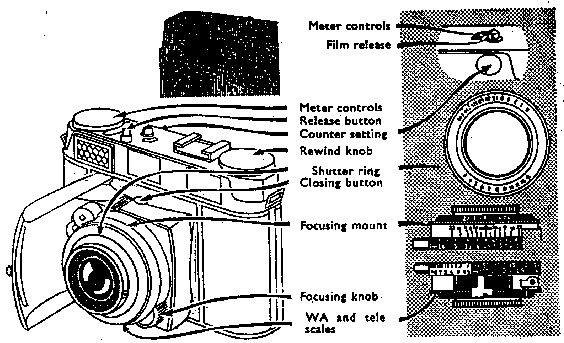
The exposure meter controls consist of a meter knob which carries a film speed scale and controls a setting pointer in the meter window. The release button incorporates a cable release socket. The film release permits advance of the film without making an exposure. The film counter is set by a counter setting button in the back of the camera. The closing button on the top of the lens panel permits the camera to be closed. The rewind knob incorporates a film indicator.The focusing mount on the top of the lens carries the distance scale and moves past the depth of field indicator. The shutter ring carries the shutter speeds and is cross-coupled with the aperture scale. The exposure values are engraved on the same ring. The wide angle and telephoto distance scales on the under-side of the focusing mount serve for focusing the camera with these alternative lenses.
The details and description apply to the Retina IIIC. The Retina IIC is similar but has no exposure meter (inset).

Shooting with the Retina IIIC and IIC. From left to right: Advance the film and tension the shutter with the rapid winding lever; set the exposure value; select the aperture-speed combination you want; rotate the focusing mount by the focusing knob until the rangefinder images fuse into one; press the release button to expose.
Loading
- Open the camera back.
- Insert the film cassette.
- Fix the film end to the take-up spool.
- Close the camera back.
- Set the film counter. Depress the film release button and at the same time push the film counter setting button (on the back of the camera top) in the direction of the arrow. Repeat this until the diamond-shaped mark between the figures 1 and 36 (in the cut-out counter window) is opposite the notch in the upper edge of the film counter window. With a 20-exposure cassette, set the film counter to the diamond mark at the figure 23. The film counter indicates the number of exposures still available in the camera.
- Make two blind exposures.
- Set the film indicator. Hold the rewind knob and turn the inner serrated ring until the triangular mark points to the type of film in the camera. (This acts as a reminder and does not affect the exposure).
- Set the film speed. On models with built-in exposure meter, turn the film speed disc of the exposure meter (by the small button) until the cut-out near the rim of the speed disc indicates the correct ASA or DIN value.
Unloading
- Set for rewinding by depressing the reversing button in the base-plate of the camera.
- Rewind the film by turning the rewind knob on the camera top in the direction of the engraved arrow until the reversing button stops to rotate. This is easily noted by the black dot near its rim. On most models you can pull out the knob half-way for more convenient rewinding.
- Open the camera back.
- Remove the cassette after fully pulling up the rewind knob.
EARLIER B AND C MODELS
|
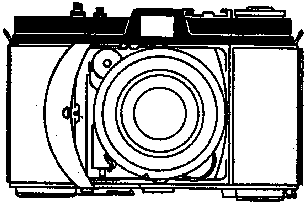
The 1954 Retina Ib has a simpler viewfinder and no exposure meter. The upper part of the body differs therefore in appearance, but otherwise the camera is similar to the current model.
|
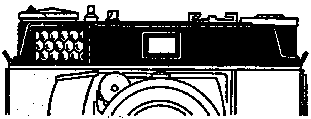
The 1957 Retina IB has a built-in exposure meter, but the same finder as the 1954 model. The current Ib (1958) has an enlarged viewfinder with two front windows, and looks very similar to the IIIC. The windows are, however, closer together.
|
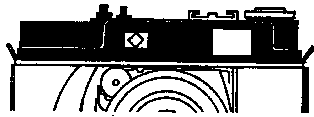
The Retina IIc of 1954 has a simpler viewfinder (one focal length only); other features as IIC.
|
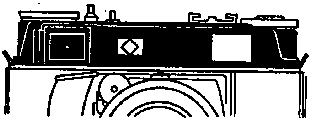
The Retina IIIc of 1954 is similar to the IIc, but with a two-range exposure meter.
|
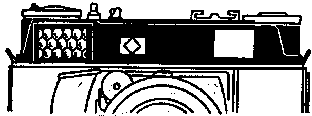
The Retina IIIc of 1957 has a modified exposure meter for simpler operation with one measuring range, as fitted on the current models.
|
Shooting
To start with, open the camera front by pushing the small milled button on the hinged front panel in the direction of the camera centre. At the same time, pull open the front until it engages with an audible click.
- Work the film transport by swinging out the rapid wind lever on the camera base as far as it will go, then let it shoot back.
- Set the exposure value. The shutter rim carries a range of numbers engraved in red from 2 to 18 which are exposure values for correct exposure. Each exposure value represents a range of shutter speed-aperture combinations covered by a single setting. To set the exposure value, slightly pull out the serrated. lever underneath the shutter and move the index line on it to the appropriate exposure value on the scale. Intermediate exposure values, e.g. l0½, 11½, etc., can also be set.
- The exposure value is obtained in the Retina IB, IIIc and IIIC from the built-in exposure meter and in models Ib, IIc and IIC from an exposure table or separate exposure meter.
- Select the aperture-speed combination by turning the milled shutter ring (press the exposure value lever against it while turning) until the combination you want is opposite the white dot next to the aperture scale. The other pairs of aperture and speed figures opposite each other are alternative combinations that you can set. On early Ib, IIc and IIIc models the aperture scale is next to the exposure value scale, and the exposure value pointer at the same time also indicates the aperture setting.
- Focus. To focus Retinas without rangefinder (Ib and IB) estimate or measure the distance of the subject with a separate rangefinder, and set this on the distance scale. Move the focusing lever (the serrated wheel behind the shutter) until the focusing index is opposite the required distance (white numbers on black background).
On Retinas with built-in rangefinder (IIc, IIC, IIIc and IIIC) look through the viewfinder and watch the image especially in the bright centre circle (a diamond-shaped area on models IIc and IIIc). Turn the focusing lever behind the shutter to make the double outlines in the rangefinder field merge into one. The camera is now set to the correct subject distance.
- Determine the picture area. On Retina Ib, IB, IIc and IIIc models the view reproduced on the film is that outlined by white frame visible in the finder. The Retina IIC and IIIC carry three bright-line frames (for 35 mm., 50 mm. and 80 mm. lenses). There the middle frame gives the correct field covered on the film where using the 50 mm. standard lens.
To compensate for the finder parallax at near subject distances (about 3 ft.) the two horizontal marks on the bright-line frame indicate the upper limit of the field of view. On models IIc and IIIc the view is also displaced sideways as indicated by the two marks at the left of the top and bottom frame line.
- Release the shutter gently. To close the camera, set the focusing scale to infinity, simultaneously press the two buttons on the side of the lens panel with two fingers of one hand, and fold up the camera front.
THE IB, IIIc AND IIIC EXPOSURE METER
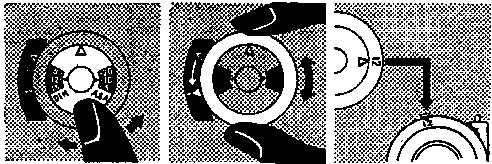
Above: The Retina IB, IIIc and IIIC have a built-in exposure meter. To use it, set the film speed (left), point the camera at the subject, and turn the meter setting ring until the yellow setting pointer coincides with the exposure meter needle (centre). Then read off the exposure value and set it on the shutter (right).
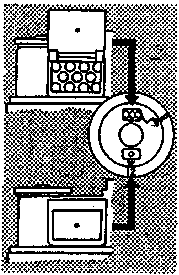
Left: Earlier Retina IIIc models have a slightly different meter with two ranges. In bright light keep the cover closed, and read off the exposure value opposite the symbol of a small circle in a rectangle. In poor light open the cover, and read off the exposure value opposite the symbol for the cell.
|
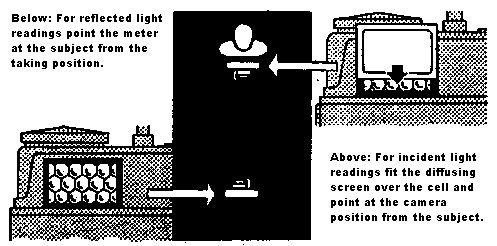
The Retina IB, IIIc and IIIC Exposure Meter
To use the built-in meter of the Retina IB, IIIc and IIIC:
- Set the film speed. (see loading, No. 8).
- Point the camera at the subject, taking care not to obstruct the honey-comb cell of the exposure meter.
- With the single-range meter of the Retina IB, later IIIc and IIIC, turn the meter setting ring to line up the yellow pointer in the meter window with the position of the white needle. Read off the exposure value opposite the red triangular mark on the meter setting ring.
- On the two-range meter of the early Retina IIIc, keep the meter cover closed in bright light and read off the exposure value opposite the symbol of a small circle in a rectangle. In poor light, open the cover and read off the exposure value opposite the symbol of the honeycomb cell.
- Set the exposure value on the camera shutter (see shooting, No.2).
Special Controls
FOR TIME EXPOSURES, set the index of the shutter speed ring to B (= brief time). A cable release screws into the release button.
THE DELAYED ACTION RELEASE for self-portraits built into the Synchro-Compur is brought into action by moving the green lever on the lower left part of the shutter to "V". Operate the rapid winding lever first.
FLASH SETTINGS. For X- or M-synchronization, set the green lever on the bottom left side of the shutter to X or M.
|
The Retina I, Ia, II and IIa
These earlier models, produced between 1934 and 1954, have a folding front cover, with the lens panel connected to the body by leather bellows. Opening the front brings the lens panel forward into the shooting position. This design makes the camera flat and protects the lens when closed.
The early Retina I models underwent appreciable changes during the first few years on the market, with various rearrangements of the layout of controls. For convenience we list the main groups in three series which are more or less similar in handling.
THE FIRST SERIES OF RETINA I MODELS, produced between 1934 and 1936, have black stove-enamelled metal parts, are leather covered, and carry a film transport knob incorporating a reversing control for film rewinding. The transport is arrested by an automatic film lock with a film release in the form of a knob on the top of the camera. Later models of this series have a lever at the back. The lens is a 2 in. (50 mm.) Xenar f3.5 in a Compur (up to 1/300 sec.) or Compur-Rapid shutter (up to 1/500 sec.) shutter. This is tensioned by a tensioning lever on the shutter. The release button is also fitted on the shutter itself. A depth of field calculating disc is fitted in the camera base.
THE SECOND SERIES OF RETINA I MODELS (l936-1938) differs from the first series above in having a chrome body finish. The film release lever is on the camera back next to the viewfinder, and the reversing lever is alongside below the film transport knob. Models from 1937 onwards have a body release button in the top of the camera and an accessory shoe. The lens is a 2 in. (50 mm.) Xenar, Tessar, or Ektar f3.5, in a Compur or Compur-Rapid shutter.
THE THIRD SERIES OF RETINA I MODELS (l939-l949) has no separate film release as this is here coupled to the shutter release on the camera. On models from 1946 onwards the shutter release is interlocked with the film transport, preventing double exposure. The 1949 model also has a flash-synchronized shutter, a depth of field scale adjacent to the distance scale on the camera focusing mount, and a film indicator.
THE RETINA Ia, introduced in 1951, features fairly extensive new developments. This model has a rapid winding lever with built-in exposure counter. In addition to the automatic film release, there is again a separate film release button in the top. The rapid winding lever also tensions the shutter automatically. The shutter in earlier models is an X-synchronized Compur-Rapid, in later ones an XM-synchronized Synchro-Compur. Other features are a re-designed precision film track and, on later models, a film indicator built into the rewind knob (and not fitted underneath, as before).
THE ORIGINAL RETINA II of 1937 is similar to the Retina I, second series, but with built-in rangefinder coupled to the lens. The rangefinder eyepiece is separate from the viewfinder. The shutter is a Compur-Rapid, and the lens a 2 in. (50 mm.) Ektar f3.5, Xenar f2.8 or Xenon f2.5. The release button is on top of the body.
THE LATER RETINA II(1939-1949) is similar to the third series of Retina I, but has a rangefinder combined with the viewfinder in one eyepiece. Since 1949 a film indicator is fitted and an X-synchronized Compur-Rapid shutter. The lens is a 2 in. (50 mm.) Xenon f2 or Heligon f2. There. is no film release. The film counter is set by a wheel next to the reversing lever in the back.
THE RETINA IIa (1951) is similar to the Retina Ia, but has a built-in rangefinder in one eyepiece with the viewfinder, coupled to the lens. The latter is a 2 in. (50 mm.) Xenar or Heligon f2 in a Compur-Rapid (X-synchronized) or Synchro-Compur (XM-synchronized) shutter.
SCREW-IN FILTERS for the Retina I are 27 mm. in diameter, and for the Retina II 32 mm. (except the Ektar f2 which accepts 32.5 mm. push-on filters). All models take push-on lens hoods of the same size.
FOR CLOSE-UP WORK with models Ia and IIa a series of NI NII and NIII close-up lenses is available covering distances from 35½ to 8¾ in., used with a special close-up rangefinder.
OTHER ACCESSORIES FOR THE Ia AND IIa INCLUDE a table stand (with copying field frames and R-lenses for ultra close-ups) and microscope attachment.
THE RETINA IIa
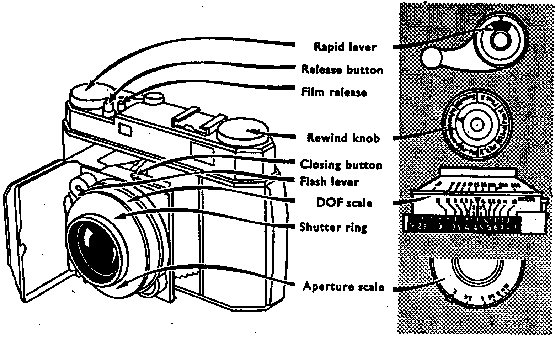
The rapid winding lever incorporates the film counter. The release button carries a cable release socket. The film release permits advancing the film without making an exposure. The rewind knob incorporates a film indicator. The closing button releases the lock which enables the bellows to be folded up and the front closed. The flash lever selects the synchronization (M or X). The focusing mount carries a distance scale that moves past the depth of field indicator. The shutter speed scale is engraved on the front of the shutter; speeds are set by moving an index mark on the ring opposite the required time.
The above details and illustrations apply to the Retina IIa. The Retina Ia is similar but has no rangefinder; the viewfinder is instead in the centre of the camera top.

Shooting with the Retina IIa and Ia. From left to right: Advance the film and tension the shutter with the rapid winding lever; set the aperture; set the shutter speed; move the focusing knob to focus the lens (with the coupled rangefinder on the Retina IIa); press the release button to expose.
Loading
- Open the camera back by lifting up the back latch.
- Insert the film cassette. Pull out the milled knob above the empty film chamber. Insert the film cassette so that the projecting spool peg lies in the recess in the bottom of the spool chamber. The reversing control (the lever of the second and third series of Retina I and all Retina II models on the camera back below the film winding knob, on the clutch in the winding knob of first series Retina I models) must be set to "A".
Pull out about 3½ in. of film from the cassette, and thread the end of the film into one of the slits in the take-up spool.
In the Retina Ia and IIa turn the built-in take-up spool so that the slot faces the camera back. Fix the film end in the slot. Make sure that the film lies flat in its groove between the spools.
- Close the camera back.
- Make two blind exposures. With the first series of the Retina I give the film release a quarter turn in the direction of its arrow, then turn the winding knob in the direction of its arrow until a faint click is heard, and the winding knob locks. Repeat this procedure a second time and the two blind exposures are made. Now wind once more after turning the film release.
WITH THE SECOND SERIES OF THE RETINA I (AND EARLY RETINA II MODELS) move the film release lever in the camera back (to the right of the viewfinder) to the right. Then turn the winding knob in the direction of its arrow until a faint click is heard, and the winding knob locks. Repeat a second time and the two blind exposures are made. Now wind once more after moving the film release.
WITH THE THIRD SERIES OF THE RETINA I AND LATER RETINA II MODELS turn the winding knob in the direction of its arrow until it locks. Then open the camera front, tension the shutter and press the release button. Repeat this a second time and the two blind exposures are made. Now wind on once more.
WITH THE RETINA IA AND IIA this is combined with setting the film counter (below).
- Set the film counter. On the first series of the Retina I turn the milled knob in the centre of the film counting disc until No. 1 on the dial is opposite the engraved index line.
ON THE SECOND SERIES OF THE RETINA I move the film release lever backwards and forwards until No.1 on the dial is opposite the index (arrowhead).
ON THE THIRD SERIES OF THE RETINA I AND EARLY RETINA II MODELS turn the counting disc by means of the two lugs until No.1 is opposite the index (arrowhead).
ON THE LATER RETINA II MODELS (with range and viewfinder in one eyepiece) press in the milled wheel which is let into the camera back, below the film winding knob, at the same time turning it until the figure 1 is opposite the indicator on the dial.
ON THE RETINA IA AND IIA set the counter before making the blind exposures. Turn the milled ring on top of the rapid winding lever in the direction of the arrow until the diamond mark next to No. 36 is opposite the index (arrowhead). With 20-exposure cassettes, use the diamond mark next to No.20. Pull out the rapid winding lever, let it shoot back, and press the film release button. Repeat until the arrowhead is opposite No.36 (or No.20). The film counter thus shows the number of frames still unexposed.
- Set the film indicator on the models so fitted.
Unloading
- Set for rewinding. Move the reversing lever or clutch from A (advance) to R (rewind) to uncouple the winding knob or lever from the take-up spool and allow spooling the exposed film back into the cassette from the take-up spool.
ON THE RETINA IA AND IIA depress the reversing button in the bottom of the camera.
- Rewind the Film. Turn the rewind knob in the direction,of the arrow engraved on it until all the film is wound back; at that point the resistance of film rewinding ceases and the rewind knob turns more freely.
ON THE RETINA II the rewind key is locked. Keep the film rewind release knob above the back latch pressed in the direction of the engraved arrow while rewinding. When the film is rewound, let go of the film rewind release, and turn the rewind knob until it engages. If this is not done the rangefinder window remains obscured.
- Open the camera back.
- Remove the cassette by pulling up the rewind knob.
EARLY RETINA MODELS
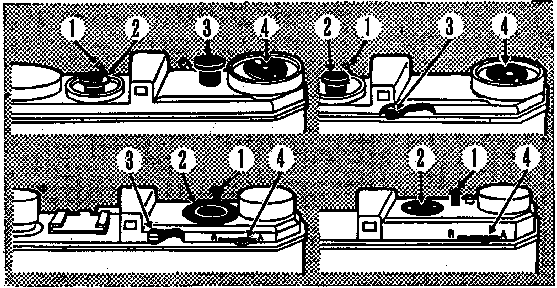
The pre-war models of the Retina I can conveniently be divided into three series. The first series (top left) have a reversing clutch built into the transparent knob, the shutter release on the front of the camera and a film release knob next to the transparent knob. Later versions have the film release lever In the back (top right). The second series (lower left) models have a reversing lever In the camera back, and a body release on the top of the camera. The third series Retina I models (lower right) have no separate film release.
In all cases the parts numbered are:
1. shutter release;
2. film counter;
3, film release;
4, reversing clutch or lever.
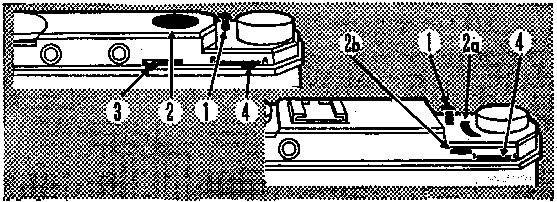
The first models of the Retina II, with separate eyepieces for the viewfinder and the rangefinder, correspond to the second series of the Retina I (left). Later Retina II models have only one eyepiece for the viewfinder and the rangefinder, and correspond in manipulation to the third series of Retina I (right). The only difference is that the film counter (2a) is behind a window in the top and is set by a special wheel (2b) in the back of the camera. There is again no film release in these later models.
Shooting
- Open the camera front by pressing the small button in the base of the camera. Pull out the front to its full extent, when it will click and lock into position.
- Advance the film by turning the transport knob or pulling out the lever as far as it will go. On the Retina Ia and IIa this also automatically tensions the shutter.
- Set the shutter speed. Turn the chromed milled ring on the shutter front to bring the black index mark (engraved on the ring on models since 1949) opposite the exposure time required. The shutter speed range is 1, ½, 1/5, 1/10, l/25, 1/50, 1/100 and 1/300 sec. (1/250 and 1/500 on some models).
Earlier Retina I and II models have the speeds marked on the ring, and the index mark on the front of the shutter.
ON THE RETINA I AND II tension the shutter separately by pulling down the tensioning lever on the rim of the shutter.
- Set the aperture (stop) by moving the aperture setting lever on the shutter rim to the required aperture figure. On some Retina I models the aperture indicator and scale appear twice -- one is on top when holding the camera vertically, the other one when holding it horizontally -- to allow reading off the aperture in either position.
- Set the distance. ON THE RETINA I AND IA turn the focusing scale (the milled ring in front of the lens panel) to bring the required distance figure opposite the long white or black line which forms the distance index. Some Retina I models have two distance scales; one engraved in black, the other one in red. The black scale is used when holding the camera vertically, the red one when held horizontally.
ON THE RETINA II AND IIA the distance is determined with the built-in rangefinder, which is coupled to the lens. To use the rangefinder, look through the rangefinder eyepiece (on the left side, below the rewind knob). Two images of the subject appear, one in the large finder field and the second one in the slightly golden coloured centre of the large field. (The later Retina II as well as IIa models have the rangefinder combined in one eyepiece with the viewfinder). Move the focusing lever attached to the focusing mount with the distance scale until the two images fuse into one. This at the same time sets the lens to the correct distance which can be read off the scale. Later models have also a red line or dot for correct settings with infra-red film.
- Determine the picture area. The film records everything visible inside the finder.
- Release by gently pressing the release button, or, on early Retina I models, the plunger, on the shutter.
TO CLOSE THE RETINA, turn the focusing scale back to infinity. You cannot close the camera in any other position. Press in the two buttons, one on each side of the lens panel and fold up the camera front.
Special Controls
FOR TIME EXPOSURES set the shutter to B (= brief time). The Retina I models of the first and second series have also T (long time) setting. Pressing the release at this setting opens the shutter and keeps it open. To close, press the release a second time. The shutter of these models does not require tensioning on B or T.
THE CABLE RELEASE SOCKET of Retina Ia and IIa models is the release button. On the third series of Retina I models and on all Retina II models the cable release screws into the socket next to the release button. On series I and series II Retina I models the cable release socket is on the shutter itself (unscrew the release plunger first on models without body release).
FLASH SETTINGS. On later Retina Ia and IIa models set the synchronizing lever at the top of the shutter rim to X or M as required. Early Retina models Ia and IIa as well as models I and II after 1949 are only X-synchronized. The shutter of older Retinas before 1949 is not synchronized for flash but this can be built in afterwards.
CHANGING PARTLY-EXPOSED FILMS is substantially the same for all Retinas with film release lever or button, as for current models. Retina models between 1939 and 1950 have no film release lever. To advance the partly exposed film after reloading cover the lens with some opaque material and as an additional precaution stop fully down with the shutter set to its top speed. Release the shutter and advance the film repeatedly until the film counter has advanced by the number of frames previously exposed.
|
The Retina S Lens System
The Retina IIIS standard lens can be removed as a whole and replaced by wide-angle and telephoto lenses. These are coupled with the rangefinder. The finder shows the correct view.
The standard lenses, the 2 in. (50 mm.) Xenar and Ysarex f2.8, are three-component lenses with cemented back element. The angle covered is 47º. The lenses have a helical focusing mount and are changed in a bayonet fitting.
The 2 in. (50 mm.) Xenon and Heligon f1.9 lenses are alternative standard lenses of higher speed. They are six-element anastigmats.
The Wide-angle Lenses
The 1 1/8 in. (28mm.) Curtagon f4 increases the angle of view to 75º compared with 47º of the standard lens.
The 28 mm. Curtagon accepts the 60 mm. Retina filters; the lens front is recessed so that no extra lens hood is required. The field of view of the 28 mm. lens is not shown in the camera finder and a special optical finder (No. 14727), giving the field of view of the 28 mm. lens, is available to fit into the camera accessory shoe.
The 1 3/8 in. (35 mm.) Curtagon f2.8 and Euryon f4 increase the angle of view to 64º.
Both accept the same 32 mm. screw-in filters and rectangular bayonet-fitting lens hood as standard 50 mm. lenses.
The Tele Lenses
The 3 3/8 in. (85 mm.) Tele Arton and Rotelar f4 decrease the angle of view to 29º, magnifying the image 1.7 times as compared with the standard lens. They accept the standard 32 mm. screw-in filters and a supplementary rectangular lens hood to the standard hood.
The 5 3/8 in. (135 mm.) TeleXenar and Rotelar f4 reduce the angle of view to 18½º, giving a 2.7 times magnification compared with the standard lens. They use 60 mm. diameter filters and a special round slip-on lens hood (No.25247).
The 7 7/8 in. (200 mm.) Tele Xenar reduces the angle of view to 12º, giving 4x magnification compared with the standard lens. This lens is supplied complete with skylight and medium yellow filter, lenshood and case.
Lens Changing
To remove the lens, press down the lens catch (the flat lever) below the shutter with the thumb of your left hand and at the same time turn the lens mount by the large serrated ring anti-clockwise as far as it will go. Now lift the whole lens out of the shutter.
To fit a lens to the lens mount, place the red dot on the lens opposite the red dot on the lens mount bayonet ring. Turn the lens clockwise by the large serrated ring, past a definite resistance till it clicks into position. When fitting an f4 lens, first turn the setting wheel until the red figure 4 on the aperture scale is opposite the triangular mark.
INTERCHANGEABLE LENSES
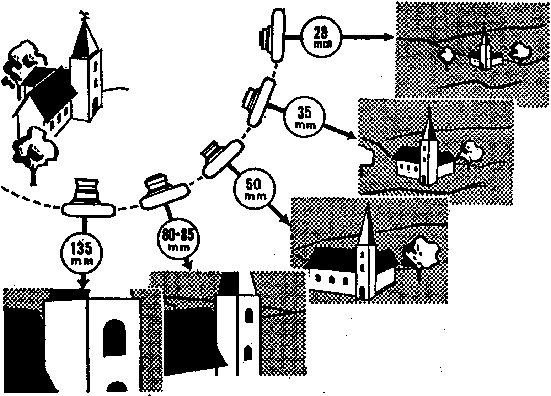
Above: The interchangeable lenses greatly increase the versatility of Retina c/C and IIIS models. The wide-angle lens (top) covers a large angle view as compared with the standard lens (centre) but shows the subject on a very small scale. The telephoto lens on the other hand includes a narrower angle, but shows distant subjects larger (bottom). The extremes of the range (28 and 135 mm.) are only available with the Retina IIIS.

Changing lenses. Left: To remove the lens from the Retina c/C series turn the front component anti-clockwise and lift out. Centre: On the Retina IIIS press the catch below the lens and turn the milled mounting ring anti-clockwise. Right:With either type insert by placing the red dot on the lens mounting opposite the red dot on the camera, drop the lens in and turn clockwise to lock.
|
The Retina C Lens System
The lenses of the folding c and C series of Retina models are convertible. That is to say the front component can be removed and replaced by alternative front units to form complete wide-angle and tele lens systems with the built-in rear section.
The 2 in. (5 cm.) Xenon C and Heligon C f2.8 or f2 are four-element six-lens anastigmats. The angle covered is 47º.
With a standard Retina Xenon C lens only the alternative Retina Xenon C units can be used. Similarly, the alternative Retina Heligon C units must only be used with the standard Retina Heligon C lens. This is a matter of matching the precise optical designs; the Xenar C and Heligon C lens systems yield identical performance.
When changing lenses, also be sure not to change the standard lens removed from your Retina against that from another Retina. The serial number engraved on the standard lens must be identical with the serial number engraved on the bayonet mount of the camera.
It is thus not possible to use the front component of an f2 lens from a Retina IIIC with the rear component of an f2.8 lens on a Retina IIC. The alternative wide-angle and tele-focus units will, however, go with the rear half of either the standard f2 or f2.8 lens.
The Wide-angle Units
The 1 3/8 in. (35 mm.) Retina-Curtar Xenon C or Heligon C are available with an aperture of f4 or alternatively with an aperture f5.6. They increase the angle of view to 64º.
Filters for the f5.6 lenses are of the 32 mm. screw-in type and a supplementary rectangular bayonet hood is available. The f4 lenses use 60 mm. filters and a round slip-on hood, 60 mm. in diameter.
The Tele Units
The 3 1/8 in. (80 mm.) Retina-Longar Xenon C or Heligon C f4 reduce the angle of view to 30º, giving a linear magnification of 1.6 times.
Filters 60 mm. in diameter and a round slip-on lens hood with a 60 mm. mount are used on these lenses.
The nearest focusing distance with the tele lenses is about 6½ ft. For nearer shots a special T 1/60 supplementary lens is used to cover a focusing range from 6½ to 3¼ ft.
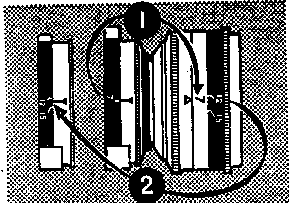
Left:To focus with alternative lens units, first focus with the camera rangefinder in the normal way. 1. Read off the distance figure on the focusing scale and set the front lens ring (white scale) to the same figure. 2. Read off the corresponding figure on the the black scale and set the camera focusing scale to that new figure.
|
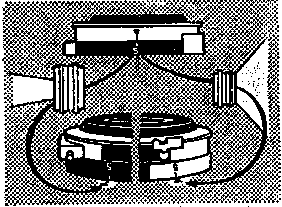
Right: Older Retina C lenses have only one distance scale on the front lens ring. In that case, focus with the rangefinder as before, read off the distance setting, and set the alternative focusing scale underneath the shutter to the appropriate figure for tele lenses (white. figures on black) against the T mark or for wide-angle lenses (black figures on white) against the triangular index mark.
|
Below: Various accessory finders are available for earlier Retina c models without multiple frames in the camera viewfinder. The optical finder (left) covers focal lengths of 35 and 80 mm. The frame finder model c (centre left) is useful for sports and action subjects and also has a reducing mask for the 80 mm. lens. The frame finder model b (centre right) has no supplementary frames and is intended for current Retina C and S models as well as the IB and Ib. The right-angle finder (right) attaches to the rear of the finder eyepiece of current Retina models for viewing from above (for instance in copying and similar applications).

Lens Changing
To remove the front component of the standard lens, rotate it anti-clockwise as far as it will go, and lift it out of the shutter. A special lens container designed to clip over the front of the standard lens makes changing easy and also holds the front component safely protected while an alternative unit is on the camera.
On some very early Retina IIc and IIIc cameras depress the catch carrying the red dot before removing the lens.
To insert the alternative lens unit in the shutter, place the red dot on the mount of the lens opposite the red dot on the bayonet fitting. Then turn the lens clockwise as far as it will go, to engage the bayonet lock.
Focusing and Depth of Field
The alternative lenses are not directly coupled to the camera rangefinder, but the latter can still be used for focusing.
First measure the subject distance with the built-in rangefinder and read off the figure obtained on the distance scale on top of the camera. Then set this figure on the white scale ring of the alternative lens opposite the red triangular index. This scale ring is marked in red: "35 mm." on the wide-angle lens and "80 mm." on the telephoto lens.
Now read off the distance figure on the black scale of your alternative lens unit opposite the red triangular index. Reset the distance scale of the camera to get this new distance figure opposite the focusing index. The camera is now correctly focused at the measured distance for the alternative lens.
Early alternative Retina lenses have no comparison scale. In that case use the two scales below the lens panel on the camera, on the other side of the distance scale, for focusing. Again focus with the rangefinder and read off the distance on the standard scale. Move the focusing lever to set the distance opposite the triangle mark on the scale (black figures on white), for wide-angle shots or opposite the T-index mark on the black scale (white figures on black) for telephoto shots. The yellow figures on the black telephoto scale are for exposures with the telephoto lens in conjunction with the T1/60 close-up lens at distances between 6 and 3½ ft.
Both tele and wide-angle lenses have their own depth of field indicator on the lens mount.
For both lenses the same aperture and shutter speeds are applicable as for the normal lens; but you cannot use a wider opening than the largest aperture of the lens employed (that is, f4 with the tele lens and f4 or f5.6 with the wide-angle one).
Viewfinding
The viewfinder of Retina C models since 1958 shows separate sets of bright-frames for the field covered by the 35 mm., 50 mm. and 80 mm. lenses. You therefore see at the same time which lens is the most suitable one for any given subject. The short lines on the image frames serve for parallax correction with near subjects closer than 8 ft.
Earlier Retina C models show only the field of view for the standard 50 mm. lens in the finder. Special accessory viewfinders are required.
|
Retina Accessories
Supplementary Lenses for Close-ups
While the unaided Retina focuses down to approximately 2½-3 ft. (according to the model), one can work at still shorter distances with the aid of the Retina supplementary lenses. This covers close-up subjects such as small objects, plants, etc., and also copying.
There are two ranges of close-up lenses: N for distances down to about 12 in. and R for still nearer shots (described later on in conjunction with the close-up attachment).
THE RETINA NI SUPPLEMENTARY LENS (marked by one ring around the circumference) covers distances between about 38 in. and 18 in.
THE RETINA NII SUPPLEMENTARY LENS (marked by two rings) covers distances between about 20 in. and l3½ in.
THE RETINA NI AND NII LENSES COMBINED (screwed into each other) cover distances between about 15 in. and 12 in.
THE RETINA NIII SUPPLEMENTARY LENS (with three rings) used to be available for a similar range to that covered by the NI and NII lenses combined. It is now discontinued.
The Retina supplementary lenses are identical with the set supplied with the close-up rangefinder.
There are no supplementary lenses available for Retina IIIS with f1.9 lens.
Besides the above lenses, the makers used to supply a range of lenses of slightly different performance Those lenses have no featuring mark.
The supplementary lenses are screwed into the front of the camera lens; the distance should be measured from the supplementary lens to the subject. No increase in exposure time is called for but it is advisable to stop down to f5.6 when using them
For ultra close-ups, the table stand is useful.
The Retina Close-up Rangefinder
This consists of a separate rangefinder which fits into the accessory shoe of the Retina. Different models are available for the various Retinas. One version (marked F=50) fits B, c, C and IIIS (f2.8 lens) models, another (marked F=45) fits the Retina IIS. Earlier versions are for the Retina I and Ia with f3.5 and f2.8 lenses (marked 3.5/50 and 2.8/50 respectively on the focusing wheel) and for the Retina II and IIa with f2 lens (marked 2/50)
The close-up rangefinder is supplied with a set of supplementary NI and NII lenses (NI, NII and NIII for earlier outfits). The procedure for close-ups is as follows.
- Attach the close-up rangefinder to the camera by pushing it into the accessory shoe as far as it will go. Be sure to use the correct model for the camera (above).
- Sight the subject. Approach the subject until the required subject area fills the blue violet finder field. Hold the camera so that the yellow field appears in the centre.
- Focus the close-up rangefinder and attach the supplementary lens. Turn the focusing wheel on top of the close-up rangefinder until the subject details in the yellow and blue fields coincide. Note the position of the focusing wheel; there are three separate scales with one, two and three lines respectively. Attach the supplementary lens with the corresponding number of rings to the camera lens. When the scale with three lines is used on the current model of the close-up rangefinder screw the NI and NII lenses on top of each other over the camera lens. On earlier models the scale with three lines is used with the NIII lens.
- Focus the camera lens. Set the camera lens to the distance read off the focusing wheel. (This is not the subject distance.)
- Set stop and speed. Check the focus. Look through the rangefinder to see if the yellow and blue images still coincide. If they do not, move the whole camera forward or backward, but do not touch the focusing wheel again.
- Release the shutter.
The Retina Table Stand
This consists of a U-shaped base with an adjustable column and ball-and-socket head and a camera platform. It is specially useful for close-ups with the supplementary N lenses with or without the close-up rangefinder.
It is equally suitable for use with the ground glass screen housing for the Retina IIc to IIIC models and the close-up attachment with the R lenses. An earlier model of the table stand has a different camera platform to take Retina models Ia and IIa.
To assemble the table stand, insert the sleeve into the flange of the base and secure by tightening the clamping screw. The column which fits into the sleeve, and is held in position by a clamping screw, provides the height adjustment. Fully extended the maximum height is about 12 in. The column carries a threaded bush in the bottom and a screw at the top, and will thus take a second extension column to increase the height by 5 in. The screw takes the ball-and-socket head which carries the camera platform. This gives the camera a really firm support completely free from vibration.
When assembling the table stand, make sure that the centre of gravity of the camera is well within the area of the base of the stand, to avoid any possibility of toppling over.
The simple and positive way of mounting the camera on the camera platform also ensures accurate re-alignment if the camera is removed temporarily for unloading (e.g. to develop a few test exposures during a series of shots), or if it is interchanged against the ground glass screen adapter. The table stand is easily dismantled and can thus be carried comfortably in a brief-case.
If the table stand is to be used as a copying outfit, a right-angle head can be fitted in place of the ball-and-socket head. This fixes the optical axis of the camera exactly at 90 degrees to the plane of the base The right-angle head is particularly indispensable for copying with the close-up attachment or with the ground glass adapter.
The Retina Close-up Attachment
This accessory, suitable for use with all the Retina models since 1954, is used in conjunction with a special set of supplementary R lenses and will reproduce subjects on a scale of 1:4.5 to 1:1.5. Three lenses are provided, marked R 1:4.5, R 1:3 and R 1:2 respectively. For the largest scale of 1:1.5 the R 1:4.5 and R 1:2 lenses are combined.
Simply attach the R lens required to the camera lens and clamp the corresponding set of two legs into the appropriately marked notches of the attachment. Then approach the subject until it is in the plane of the gauge rods fixed into the front ends of the legs. The gauge rods at the same time outline the field area covered.
An earlier version of the close-up attachment for the Retina Ia and IIa uses the same R lenses in conjunction with the table stand (with slightly different camera platform) and a set of field frames in place of gauge rods.
The Retina Copying Outfit
The outfit consists of a camera holder which takes four extendible legs. The bottom ends of the legs are fixed into the four corners of a glass plate which is laid on top of the document or other matter to be copied. The camera holder also carries two adjustable lamps and arms.
The NII supplementary lens is used on Retina models Ib, IB, IIc, IIC, IIIc, IIIC, IIS and IIIS (f2.8 lens). The legs are used fully extended with the lens set to infinity (models IIc, IIIc, IIC, IIIC, IIS and IIIS with f2.8 lens) or to 50 ft. (Retina Ib and IB). This covers a field of about 7½ X 11½ in. Alternatively, the camera lens can be set to 4 ft. (Retina c, C and S series), or 5 ft. (Ib and IB), and the legs fully pushed in to cover a field of about 5½ 8½ in. A different baseplate is used in that case.
The Ground Glass Screen Housing
The ground glass screen housing provides a means of checking exactly the effect of special views (particularly close-ups) before actually making the exposure. It is suitable only for use with the Retina IIc IIC IIIc and IIIC, and consists of a housing with ground glass screen, focusing lens mount and viewing magnifier. The lens mount incorporates a duplicate of the rear component of the Retina series c and C lens, and takes the front component of the standard, wide-angle or telephoto lens.
In use the front component of the required C lens is fitted and the picture arranged and focused. The housing is then replaced on the stand by the camera, the C lens transferred to it, and the focus set as determined.
The Retina Micro-Attachment
This allows the Retina (except IIIS with f1.9 lens) to be used with any microscope with a standard eyepiece diameter of 25 mm. The attachment consists of a light metal body with a focusing eyepiece at the front, and an arm to hold the camera at the back.
To make photomicrographs with the Retina, remove the microscope eyepiece, connect the microscope tube to the micro-attachment, and re-insert the eyepiece. Mount the Retina on the camera bracket. Focus through the focusing eyepiece of the attachment, using the coarse and fine adjustment of the microscope. The focusing scale of the camera must be set to infinity and the lens to its largest stop.
An alternative version exists for models Ia and IIa; this differs only in the design of the camera bracket.
The Retina Stereo Attachment
This is suitable for Retina models IIc to IIIC only, fitted with the Xenon C or Heligon C. It is fitted on the lens mount and produces two 16 x 22 mm. pictures side by side on the normal 24 x 36 mm. frame. The prisms give 64 mm. stereo separation, i.e. the normal eye separation. The stereo transparencies (the attachment is primarily intended for colour) are viewed in the Retina Stereo Viewer.
The stereo attachment carries its own frame finder which masks the view visible through the finder of the Retina IIc and IIIc. This frame finder is not used with the models IIC and IIIC. (fold the frame down flat on the top of the attachment) which have special masks on the standard reflected frame in the camera finder to indicate the subject area covered for stereo shots.
The Retina Right-angle Finder
Occasionally, you cannot view the subject conveniently direct through the camera finder. With the Retina right-angle finder, which is pushed on the eyepiece of the Retina B, C and S, you can shoot virtually "round the corner". It also permits unobserved snapshots from low or high angles.
|
Facts and Figures
CONVERSION OF FEET AND INCHES INTO METRIC UNITS
| Many cameras are marked only in either the metric or British system, while most of the tables in this book are also given only in one system. The table below shows at a glance equivalent lengths.
|
| British to Metric
| Metric to British
|
| 1/8 in.
| 0.32 cm.
| 0.5 cm.
| 3/16 in.
|
| 1/4 in.
| 0.64 cm.
| 1 cm.
| 3/8 in.
|
| 1/2 in.
| 1.27 cm.
| 2 cm.
| 13/16 in.
|
| 1 in.
| 2.54 cm.
| 3 cm.
| 1 3/16 in.
|
| 2 in.
| 5.08 cm.
| 4 cm.
| 1 9/16 in.
|
| 3 in.
| 7.62 cm.
| 5 cm.
| 1 15/16 in.
|
| 4 in.
| 10.2 cm.
| 6 cm.
| 2 3/8 in.
|
| 5 in.
| 12.7 cm.
| 7 cm.
| 2 3/4 in.
|
| 6 in.
| 15.2 cm.
| 8 cm.
| 3 1/8 in.
|
| 7 in.
| 17.8 cm.
| 9 cm.
| 3 1/2 in.
|
| 8 in.
| 20.3 cm.
| 10 cm.
| 3 15/16 in.
|
| 9 in.
| 22.9 cm.
| 12 cm.
| 4 3/4 in.
|
| 10 in.
| 25.4 cm.
| 15 cm.
| 5 7/8 in.
|
| 11 in.
| 27.9 cm.
| 20 cm.
| 7 7/8 in.
|
| 1 ft.
| 30.5 cm.
| 25 cm.
| 9 13/16 in.
|
| 2 ft.
| 61 cm.
| 30 cm.
| 11 3/4 in.
|
| 3 ft.
| 91.4 cm.
| 40 cm.
| 15 3/4 in.
|
| 4 ft.
| 1.22 m.
| 50 cm.
| 19 3/4 in.
|
| 5 ft.
| 1.52 m.
| 60 cm.
| 23 5/8 in.
|
| 6 ft.
| 1.83 m.
| 80 cm.
| 31 1/2 in.
|
| 7 ft.
| 2.13 m.
| 100 cm.
| 39 1/2 in.
|
| 8 ft.
| 2.44 m.
| 1.5 m.
| 4 ft. 11 in.
|
| 9 ft.
| 2.74 m.
| 2 m.
| 6 ft. 7 in.
|
| 10 ft.
| 3.05 m.
| 2.5 m.
| 8 ft. 3 in.
|
| 15 ft.
| 4.57 m.
| 3 m.
| 9 ft. 10 in.
|
| 20 ft.
| 6.10 m.
| 4 m.
| 13 ft. 2 in.
|
| 30 ft.
| 9.14 m.
| 5 m.
| 16 ft. 5 in.
|
| 40 ft.
| 12.20 m.
| 10 m.
| 33 ft. 0 in.
|
| 50 ft.
| 15.24 m.
| 15 m.
| 49 ft. 2 in.
|
| 100 ft.
| 30.48 m.
| 20 m.
| 66 ft. 0 in.
|
DAYLIGHT EXPOSURE VALUES
| For Retina models without exposure meter add the respective figures in Tables 1, 2 and 3. The result is the exposure value to be set. On models without exposure value scale use table 4 to get aperture-speed combinations (set the shutter to the nearest marked speed if necessary -- e.g., 1/25 sec. for 1/30 sec.)
|
| 1. Subject and Weather
|
| Subject
| Clear
Sun
| Cloudy
Bright
| Cloudy
Medium
| Cloudy
Dull
|
| Distant landscape or seascape without foreground
| 13
| 12
| 11
| 10
|
| Distant landscape or seascape with light foreground
| 12
| 11
| 10
| 9
|
| Open streets, squares, light buildings
| 11
| 10
| 9
| 8
|
| Figures and groups in the open, near objects without heavy shade
| 10
| 9
| 8
| 7
|
| Figures and groups in the open, near objects in shade
| 9
| 8
| 7
| 6
|
| Average interiors, diffused light.
| 3
| 2
| 1
| 0
|
| 2. Month and Time
|
|
|
| May
June
July
| Aug.
April
| Sept.
March
| Oct.
Feb.
| Nov.
Dec.
Jan.
|
| 11 a.m. to 2 p.m.
| 3
| 3
| 3
| 2
| 2
|
9 a.m. to 11 a.m.
2 p.m. to 4 p.m.
| 3
| 3
| 2
| 2
| 1
|
| 4 p.m. to 6 p.m.
| 2
| 2
| 1
| 1
| 0
|
| 3. Film Speed
|
| BS
| 21º
| 23-24º
| 25-26º
| 28-29º
| 31-32º
| 34-35º
|
| ASA
| 10
| 16-20
| 25-32
| 50-64
| 100-125
| 200-250
|
|
| -2½
| -1½
| -1
| 0
| +1
| +2
|
| 4. Exposure values and aperture-speed combinations
|
Exp.
Value
| f2.8
| f4
| f5.6
| f8
| f11
| f16
| f22
|
| 3
| 1
| 2s
| 4s
| 8s
| 15s
| 30s
| 60s
|
| 4
| 1/2
| 1
| 2s
| 4s
| 8s
| 15s
| 30s
|
| 5
| 1/4
| 1/2
| 1
| 2s
| 4s
| 8s
| 15s
|
| 6
| 1/8
| 1/4
| 1/2
| 1
| 2s
| 4s
| 8s
|
| 7
| 1/15
| 1/8
| 1/4
| 1/2
| 1
| 2s
| 4s
|
| 8
| 1/30
| 1/15
| 1/8
| 1/4
| 1/2
| 1
| 2s
|
| 9
| 1/60
| 1/30
| 1/15
| 1/8
| 1/4
| 1/2
| 1
|
| 10
| 1/125
| 1/60
| 1/30
| 1/15
| 1/8
| 1/4
| 1/2
|
| 11
| 1/250
| 1/125
| 1/60
| 1/30
| 1/15
| 1/8
| 1/4
|
| 12
| 1/500
| 1/250
| 1/125
| 1/60
| 1/30
| 1/15
| 1/8
|
| 13
| --
| 1/500
| 1/250
| 1/125
| 1/60
| 1/30
| 1/15
|
| 14
| --
| --
| 1/500
| 1/250
| 1/125
| 1/60
| 1/30
|
| 15
| --
| --
| --
| 1/500
| 1/250
| 1/125
| 1/60
|
| 16
| --
| --
| --
| --
| 1/500
| 1/250
| 1/125
|
ZONE FOCUSING
|
| With 50mm. Lens
| With 35mm. Lens
| With 80-85mm. Lens
|
| Subject
| Stop
| Distance
Setting
| Depth
From --- To
| Distance
Setting
| Depth
From --- To
| Distance
Setting
| Depth
From --- To
|
| Portraits
| 8
| 4 ft.
| 3½ - 4½ ft.
| --
| --
| 6 ft.
| 5½ - 6½ ft.
|
| Children
| 8
| 6 ft.
| 5 - 7½ ft.
| 6 ft.
| 4½ - 10 ft.
| 10 ft.
| 9 - 11¼ ft.
|
| Children
| 8
| *10 ft.
| 7½ - 15 ft.
| *10 ft.
| 6 - 30 ft.
| *15 ft.
| 13 - 18 ft.
|
| Groups
| 8
| 12 ft.
| 9 - 20 ft.
| *10 ft.
| 6 - 30 ft.
| --
| --
|
| Landscapes
| 8
| *30 ft.
| 15 ft. - inf
| 15 ft.
| 7½ ft. - inf
| *70 ft.
| 35 ft. - inf
|
| Landscapes
| 11
| 22 ft.
| 10 ft. - inf
| --
| --
| 50 ft.
| 25 ft. - inf
|
| *Some Retina models have a red circle mounted near these distances to indicate useful focusing zones.
|
SHUTTER SPEEDS TO ARREST MOVEMENT WITH THE RETINA
|
| Distance between Camera and Object
|
| Subject
| 10 ft.
3 m.
| 17 ft.
5 m.
| 25 ft.
7.5 m.
| 42 ft.
12.5 m.
| 83 ft.
25 m.
| 165 ft.
50 m.
|
| Swimmer
| 1/60
| 1/30
| 1/25
| 1/15
| 1/10
| 1/5
|
| Walker
| 1/100
| 1/60
| 1/40
| 1/25
| 1/10
| 1/5
|
| Runner
| 1/300
| 1/200
| 1/125
| 1/75
| 1/60
| 1/30
|
| Cyclist
| 1/500
| 1/300
| 1/200
| 1/100
| 1/75
| 1/40
|
| Skater
| --
| 1/500
| 1/400
| 1/250
| 1/125
| 1/60
|
| Horse galloping
| 1/500
| 1/300
| 1/200
| 1/100
| 1/75
| 1/40
|
| Horse trotting
| 1/300
| 1/200
| 1/125
| 1/75
| 1/60
| 1/30
|
| Horse walking
| 1/125
| 1/75
| 1/50
| 1/30
| 1/15
| 1/10
|
| Racehorse
| --
| 1/500
| 1/400
| 1/250
| 1/125
| 1/60
|
| Waves
| 1/500
| 1/300
| 1/200
| 1/100
| 1/75
| 1/40
|
| Heavy waves
| --
| --
| 1/500
| 1/300
| 1/150
| 1/75
|
| Boats making 10 knots
| 1/300
| 1/200
| 1/125
| 1/75
| 1/60
| 1/30
|
| Boats making 20 knots
| 1/500
| 1/300
| 1/200
| 1/100
| 1/75
| 1/40
|
| Tramcar
| 1/300
| 1/200
| 1/125
| 1/75
| 1/60
| 1/30
|
| Motor car on road
| --
| --
| 1/500
| 1/300
| 1/150
| 1/75
|
| Slow train
| 1/500
| 1/300
| 1/200
| 1/100
| 1/75
| 1/40
|
| Fast train
| --
| --
| --
| 1/500
| 1/250
| 1/100
|
| Aeroplane
| --
| --
| --
| --
| 1/500
| 1/200
|
The shutter speeds as listed above are applicable to motion which cuts right across the direction in which the lens and photographer look.
If the motion photographed is at an acute angle with the direction in which the lens points the exposure time can be longer, say 1/30 second instead of 1/60.
If the subject moves directly towards the lens (or for that matter away from it) the exposure time can be three or four times longer, say 1/8 second instead of 1/30.
Where the above table shows speeds not marked on the shutter use the next faster speed.
The figures apply to the standard lens, with the tele lens multiply the denominator of the shutter speed by the magnification of the lens; e.g. 1/300 with an 85 mm. lens (magnification 1.7 times) becomes 1/500 sec.
|
APERTURES WITH CLEAR FLASH BULBS
| (For 100 ASA Film)
|
| Distance
| G.E.,
Mazda,
G.E.C. No. 1, No. 3
Philips:
PF 1
AG1
| Mazda,
G.E.,
G.E.C.:
No. 5
Philips:
PF 5
Sylvania:
Press 25
| Philips:
PF38
Sylvania:
Press 40
G.E.:
No. 11
| Philips:
PF 60
G.E.:
No. 22
Sylvania:
No. 2
|
| 6 ft. (2m.)
| 16
| --
| --
| --
|
| 8 ft (2.5m.)
| 12.5
| --
| --
| --
|
| 10 ft (3m.)
| 10
| 16
| --
| --
|
| 12 ft. (3.6m.)
| 8
| 16
| 16
| --
|
| 15 ft. (4.5m.)
| 6.3
| 11
| 12.5
| 16
|
| 20 ft. (6m.)
| 4.5
| 8
| 10
| 12.5
|
| 25 ft. (7.5m.)
| 4
| 6.3
| 8
| 11
|
| 30 ft. (9m.)
| 3.5
| 5.6
| 6.3
| 9
|
| In bright rooms (kitchen, bathroom) or with films of 200 ASA, use next smaller aperture. In very large rooms, at night outdoors or with 50 ASA films use next larger aperture.
|
APERTURES WITH BLUE FLASH BULBS
| (For 32 ASA Daylight Type Reversal Colour Film)
|
| Distance
| PF 1/B
No. 1B
AG 1B
| No. 5B
| PF 60/97
No. 22B
|
| 3½ ft. (1m.)
| 16
| --
| --
|
| 5 ft. (1.5m.)
| 11
| 16-22
| 22
|
| 7 ft. (2.2m.)
| 8
| 11-16
| 16
|
| 10 ft. (3m.)
| 5.6
| 8-11
| 11
|
FILTERS AND FACTORS
| Filter
| Filter
Code
| Factor
| Reduce Exposure
Value Setting
by
|
| Light Yellow
| F I
| 1½
| ½
|
| Medium yellow
| F II
| 2
| 1
|
| Yellow green
| F III
| 2
| 1
|
| Orange
| F IV
| 3
| 1½
|
| Red
| F V
| 7
| 3
|
| Blue
| F VI
| 2½
| 1½
|
| Ultra-violet
| --
| --
| --
|
| Polarizing Filter
| --
| 2½
| 1½
|
CLOSE-UP FOCUSING WITH SUPPLEMENTARY LENSES (INCHES)
ON 45 mm CAMERA LENS
Camera
Lens
Focusing
Scale
Setting
(Feet)
| RETINA LENS NI
| RETINA LENS NII
| RETINA LENS NI + NII
|
Supplementary
Lens to
Subject Distance*
(in inches)
| Approximate
Field size
(in inches)
| Supplementary
Lens to
Subject Distance*
(in inches)
| Approximate
Field size
(in inches)
| Supplementary
Lens to
Subject Distance*
(in inches)
| Approximate
Field size
(in inches)
|
| inf
| 37.37
| 16.75x20
| 19.37
| 8.5x12.5
| 14.37
| 5.75x8.5
|
| 25
| 33.75
| 15x22.75
| 18.37
| 7.87x11.75
| 14.12
| 5.37x8.25
|
| 15
| 32.5
| 14.37x21.75
| 18.25
| 7.75x11.5
| 13.75
| 5.25x8.12
|
| 10
| 30.25
| 13.62x20.5
| 17.62
| 7.62x11.12
| 13.5
| 5.12x7.87
|
| 8
| 29.25
| 13x19.37
| 17.25
| 7.25x10.87
| 13.37
| 5.12x7.75
|
| 7
| 28.37
| 12.5x18.5
| 17.12
| 6.87x10.5
| 13.25
| 5.12x7.62
|
| 6
| 27.12
| 12x17.87
| 16.75
| 6.75x10.37
| 13.12
| 5x7.5
|
| 5
| 26
| 11.5x17.25
| 16.37
| 6.62x10
| 12.75
| 4.87x7.25
|
| 4.5
| 25
| 11.25x16.87
| 16
| 6.5x9.75
| 12.62
| 4.87x7.12
|
| 4
| 23.75
| 10.75x16.12
| 15.62
| 6.37X9.5
| 12.5
| 4.75x6.87
|
| 3.5
| 23
| 9.87x14.87
| 15.25
| 6.12x9.12
| 12.25
| 4.5x6.75
| | * from subject to film plane
|
CLOSE-UP DEPTH OF FIELD
| f 3.5
| 37.75
39.5
41.37
| 33.75
35
36.5
| 29
30
31.25
| 25.19
26
26.81
| 20.5
21
21.56
| 19.06
19.5
20
| 15.37
16
16.25
| 11.87
12
12.25
| 10.81
11
11.19
|
| f 5.6
| 36.56
39.5
42.81
| 32.62
35
37.56
| 28.06
30
31.62
| 24.62
26
27.31
| 20.12
21
22
| 18.75
19.5
20.37
| 15.62
16
16.5
| 11.75
12
12.44
| 10.69
11
11.31
|
| f 8
| 35.44
39.5
44.62
| 32.62
35
38.87
| 27.37
30
32.56
| 24.06
26
28
| 19.75
21
22.5
| 18.44
19.5
20.81
| 15.19
16
16.75
| 11.56
12
12.62
| 10.56
11
11.44
|
| f 16
| 32.12
39.5
51.25
| 29.06
35
43.75
| 25.37
30
35.81
| 22.5
26
30.44
| 18.62
21
24.19
| 17.44
19.5
22.19
| 14.5
16
17.69
| 11.12
12
13.19
| 10.19
11
12
|
FOCUSING WITH SUPPLEMENTARY R LENSES
Lens
Used
| Gauge
Rods
| Field
(inches)
| Set
Camera
to
| Total Depth of Field*
(inches) at
|
| f 8
| f 11
| f 16
| f 22
|
| R 1:4.5
| 4.5
| 4.12x6
| inf
| 0.62
| 0.84
| 1.25
| 1.68
|
| R 1:3
| 3
| 2.87x4.12
| inf
| 0.32
| 0.43
| 0.64
| 0.67
|
| R 1:2
| 2
| 2x2.87
| inf
| 0.16
| 0.22
| 0.33
| 0.45
|
| R 1:4.5+R 1:2
| 1.5
| 1.5x2
| inf
| 0.08
| 0.10
| 0.15
| 0.20
|
| * The plane of sharpest focus is approximately in the middle of the zones given.
|
CONVERSION OF DIFFERENT SPEED SYSTEMS
ASA & BS
Arith.
(New)*
| ASA
Log
(New)
| DIN
| BS
Log
|
| 3
|
| 6
| 16º
|
| 6
| 1º
| 9
| 19º
|
| 12
| 2º
| 12
| 22º
|
| 25
| 3º
| 15
| 25º
|
| 50
| 4º
| 18
| 28º
|
| 100
| 5º
| 21
| 28º
|
| 200
| 6º
| 24
| 31º
|
| 400
| 7º
| 27
| 37º
|
| 800
| 8º
| 30
| 40º
|
| 1600
| 9º
| 33
| 43º
|
| *Also Weston III, IV and V meters.
|
35 mm. COLOUR FILMS ON THE MARKET
| Film
| Type
| Speed in
ASA and BS
Arithmetic
| Processing
|
| Negative Films
|
| Agfacolor CN14
| Universal
| 20
| U
|
| Agfacolor CN17
| Universal
| 40
| U
|
| Ferraniacolor N27
| Daylight
| 40
| U
|
| Fujicolor
| Universal
| 32
| M
|
| Ilford Colorprint
| Universal
| 64
| M
|
| Gevacolor N5
| Universal
| 25
| L
|
| Kodacolor X
| Universal
| 64
| L
|
| Telcolor
| Universal
| 16
| L
|
| Reversal Films
|
| Agfacolor CT18
| Daylight
| 50
| M
|
| Agfacolor CK20
| Artificial light
| 80
| M
|
| Ansco 50
| Daylight
| 50
| M
|
| Ansco 100
| Daylight
| 100
| M
|
| Anscochrome T100
| Artificial light
| 100
| M
|
| Anscochrome 200
| Daylight
| 200
| M
|
| Ektachrome E2
| Daylight
| 32
| U
|
| Ektachrome X
| Daylight
| 64
| U
|
| H.S. Ektachrome
| Daylight
| 160
| U
|
| H.S Ektachrome B
| Artificial light
| 125
| U
|
| Ferraniacolor
| Daylight
| 25
| U
|
| Ferraniacolor
| Artificial light
| 20
| U
|
| Ferraniacolor DIA 28
| Daylight
| 50
| M
|
| Fujicolor
| Daylight
| 10
| M
|
| Gevacolor R5
| Daylight
| 40
| M
|
| Ilford Colorslide
| Daylight
| 32
| M
|
| Ilford Super Colorslide
| Daylight
| 64
| M
|
| Kodachrome II
| Daylight
| 25
| M
|
| Kodachrome X
| Daylight
| 64
| M
|
| Kodachrome IIA
| Artificial light
| 40
| M
|
| Konicolor
| Daylight
| 16
| M
|
| Konicolor Tungsten
| Artificial Light
| 16
| M
|
| Perutz Color C18
| Daylight
| 50
| M
|
| Telcolor
| Daylight
| 50
| M
|
| PROCESSING: M = films can be processed only by the maker; L = films can be processed only by an approved laboratory through a photographic dealer: U = films can be processed by the user by means of special processing kits.
|
CURRENT SPEED OF 35 mm. BLACK-AND-WHITE FILMS
| Make
| Speed in
ASA and BS
Arithmetic
| Make
| Speed in
ASA and BS
Arithmetic
|
Adox---
KB 14
KB 17
KB 21
KB 27
UKB-17 Reversal
|
40
80
200
800
80
| Ilford---
Pan F
F.P.3
H.P.3
H.P.S
|
50
125
400
800
|
Agfa---
Isopan FF
Isopan F
Isopan ISS
Isopan Record
|
32
80
200
1250
| Kodak---
Panatomic X
Plus X
Tri-X
|
50
125
400
|
Ansco---
Super Hypan
|
500
| Konica---
Konicapan S
Konicapan SS
Konicapan SSS
|
100
200
400
|
Ferrania---
P 24
P 30
P 33
P 66
|
40
160
320
640
| ORWO, Wolfen---
NP 10
NP 18
NP 22
NP 27
|
8
50
125
400
|
Gevaert---
Gevapan 27
Gevapan 30
Gevapan 33
Gevapan 36
Dia-Direct 26
(Reversal)
|
64
125
250
500
50
| Perutz---
P 14
P 17
P 21
P 25
Miniature Reversal
|
40
80
200
500
25
|
Hauff---
Pancola 17
Pancola Granex
Pancola 21
Pancola S 25
|
40
80
200
500
| Tura---
Pan 14
Pan 17
Pan 21
Pan 24
|
40
80
200
400
|
| The ASA speeds are the minimum correct exposure ratings. Some manufacturers may, however, still be quoting their speeds according to the older system to give a more liberal exposure.
|
|
Download this guide
 The Retina Guide (1965 edition) - Acrobat PDF [660 kB]
The Retina Guide (1965 edition) - Acrobat PDF [660 kB]
More Focal Press Guides
 The Retina Reflex Guide (1970 edition)
The Retina Reflex Guide (1970 edition)
 The Retinette Guide (1965 edition)
The Retinette Guide (1965 edition)
|
You may copy and print this document or parts of this document for your own personal use. You may not, however, reprint or republish this work, in whole or in part, without prior permission from me, Mischa Koning. Such republication includes inclusion of this work in other Web sites, Web pages, FTP archives, books, magazines or other periodicals, CD-ROM and DVD-ROM compilations or any other form of publication or distribution.
|
|

